Virginia is a state with a wide variety of bird species, ranging from migratory and wintering species to year-round residents.
From the majestic Bald Eagle to the colorful Bluebird, the birds of Virginia provide a delightful and ever-changing landscape of color and sound.
This article will explore the many species of birds that can be found throughout the state and discuss their identification, habitat, and conservation status.
With over 450 species of birds, Virginia is home to one of the most diverse avian populations in the world.
1. American Goldfinch
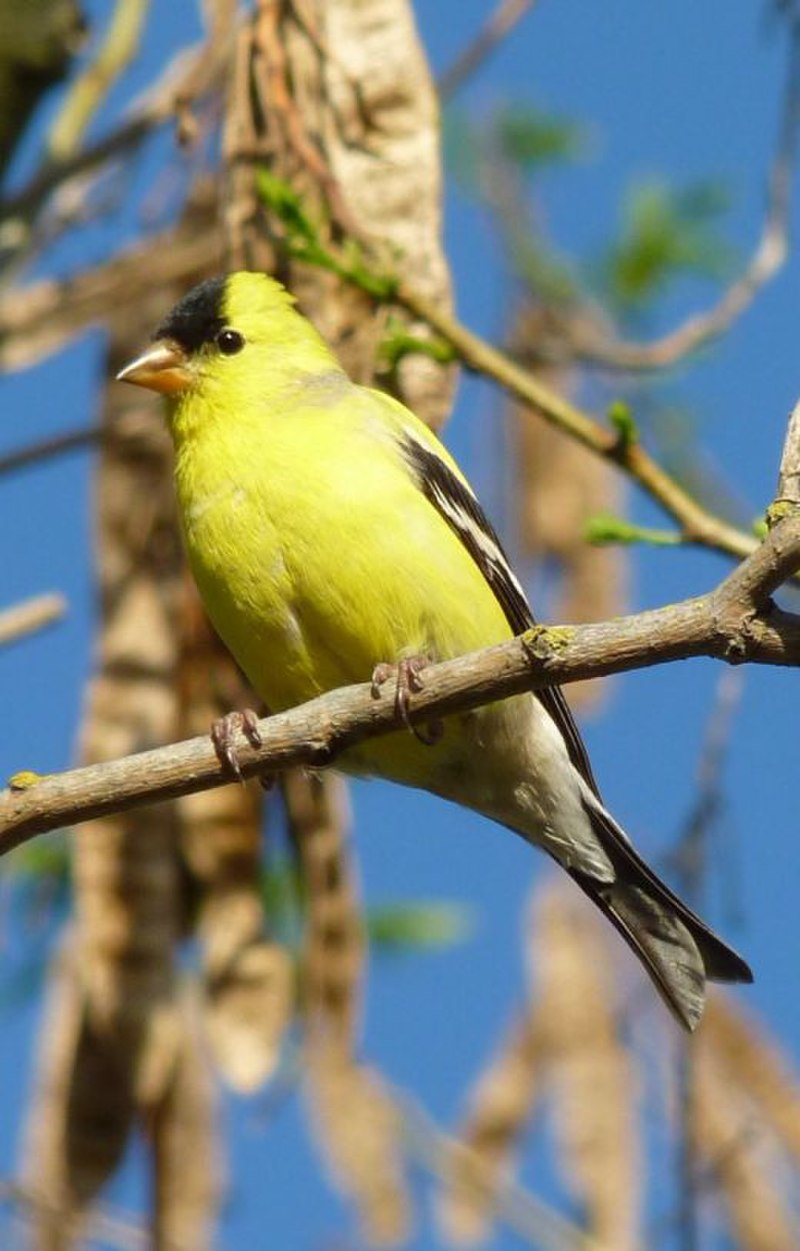
The American goldfinch is a small North American bird in the finch family. Males are vibrant yellow with black wings and tail, while females are duller in colouration.
It migrates from mid-Alberta to North Carolina during breeding season, south of Canada–United States border to Mexico for its wintering grounds.
The only finch which undergoes complete molt every year, it displays sexual dichromatism where males have brighter colours than their female counterparts.
They feed mainly on seeds but also eat insects such as aphids and caterpillars when raising youngs; they often occur near thistles or other plants that produce viable seed heads.
Their call consists of an array of chirps and trills making them quite conspicuous.Scientific classification:
| Kingdom | Animalia |
| Phylum | Chordata |
| Class | Aves |
| Order | Passeriformes |
| Family | Fringillidae |
| Subfamily | Carduelinae |
| Genus | Spinus |
| Species | S. tristis |
2. Northern Cardinal
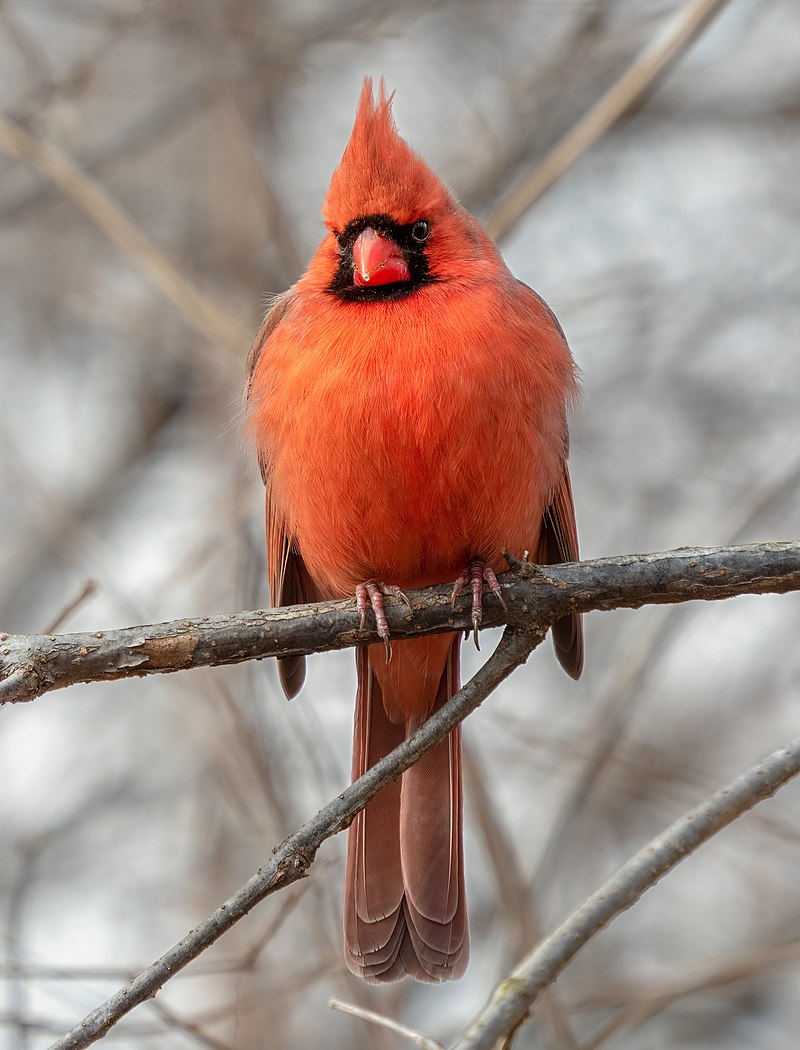
The Northern Cardinal is a beautiful bird, easily identified by its bright red plumage. It can be found in the eastern United States from Maine to Minnesota and south through Mexico and Belize.
Along with its striking colouration, it has a distinctive crest on its head and sharp black facial markings around the eyes.
Despite their small size (measuring 7-9 inches) they are very vocal birds – males sing persistently throughout springtime to attract mates or proclaim their territory.
They typically feed on insects, seeds and fruits but also enjoy suet at backyard bird feeders.
The female is less brightly coloured than her mate but still stands out among other songbirds due to her warm brownish-red feathers.
Cardinals pair for life so you may often see them together in your garden or neighbourhood park.Scientific classification:
| Kingdom | Animalia |
| Phylum | Chordata |
| Class | Aves |
| Order | Passeriformes |
| Family | Cardinalidae |
| Genus | Cardinalis |
| Species | C. cardinalis |
3. American Robin

The American robin is a migratory bird, belonging to the true thrush genus and Turdidae family.
It was named after its European counterpart due to the similar reddish-orange breast they both possess; however, they are not related closely.
This species can be seen through most of North America during winter months, as well as in parts of Mexico and Central America where it also breeds.
They have plump bodies with gray upperparts and white underparts that vary from yellow on their throats down to orange toward their bellies.
Robins feed on fruits such as berries or insects like worms which makes them an important part of ecosystems by helping disperse seeds naturally throughout these areas.Scientific classification:
| Kingdom | Animalia |
| Phylum | Chordata |
| Class | Aves |
| Order | Passeriformes |
| Family | Turdidae |
| Genus | Turdus |
| Species | T. migratorius |
4. House Finch

The House Finch is a species of finch native to western North America and has been introduced in the eastern half of the continent as well as Hawaii.
It’s an average-sized finch with adults measuring 12.5 – 15 cm (5 – 6 inches) long and having wingspans between 20 – 25 cm (8 – 10 inches).
The upperparts are brown, while its underparts range from pale grayish white to yellow depending on subspecies.
Its face is streaked or spotted with reddish coloration; males typically have brighter plumage than females due to sexual dimorphism.
They’re mostly found near human habitations such as farms and gardens where they feed on grains, fruits, insects etc., making them very popular among birders who want something colorful for their backyard.Scientific classification:
| Kingdom | Animalia |
| Phylum | Chordata |
| Class | Aves |
| Order | Passeriformes |
| Family | Fringillidae |
| Subfamily | Carduelinae |
| Genus | Haemorhous |
| Species | H. mexicanus |
5. Blue Jay
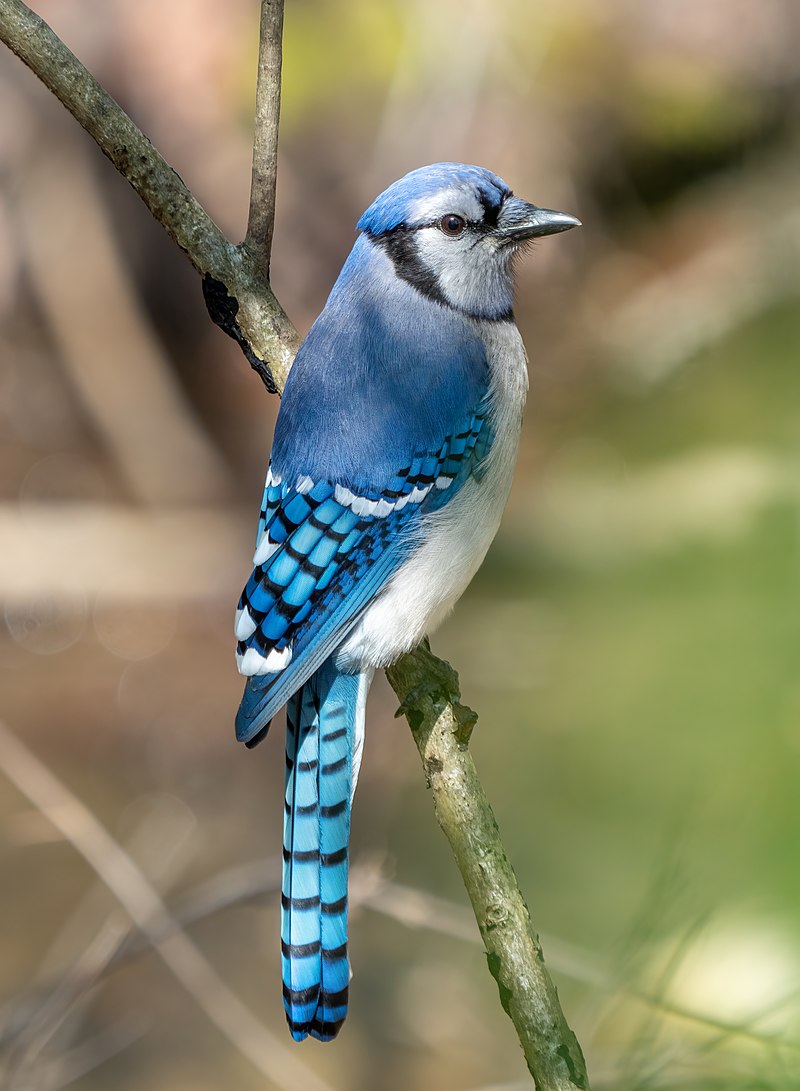
The Blue Jay is a beautiful bird that resides in eastern and central United States, as well as Newfoundland Canada.
They have an unmistakable blue colored plumage with white markings on their heads and wings.
These birds are highly adaptable to different habitats ranging from deciduous forests to urban areas.
As part of the Corvidae family, they are known for being intelligent problem solvers who will often use tools or mimic vocalizations of other species like hawks when defending their territories.
Their diet consists mostly of insects, seeds and nuts but can also include small vertebrates such as frogs or lizards if food resources become scarce.
Overall these birds provide much needed color to our environment while playing important roles in maintaining healthy ecosystems through pollination services and seed dispersal activities.Scientific classification:
| Kingdom | Animalia |
| Phylum | Chordata |
| Class | Aves |
| Order | Passeriformes |
| Family | Corvidae |
| Genus | Cyanocitta |
| Species | C. cristata |
6. Tufted Titmouse
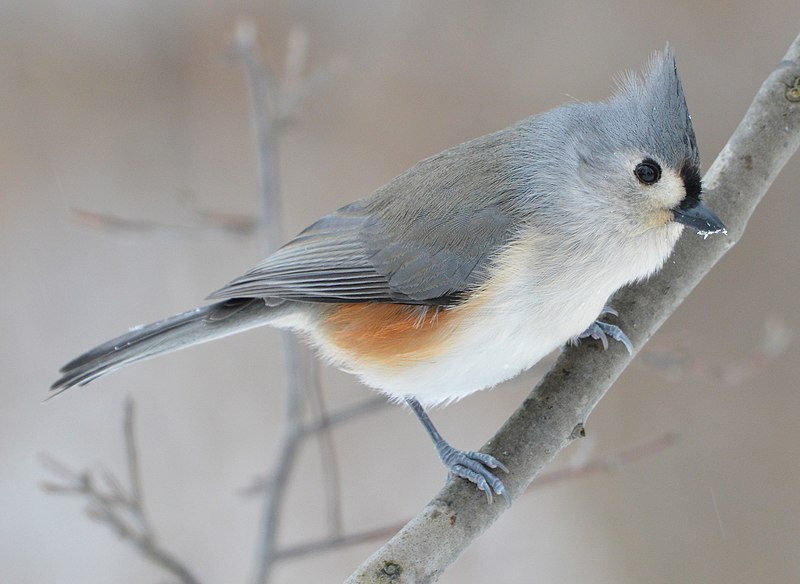
The Tufted Titmouse is a small, cheerful songbird found in North America. It’s part of the tit and chickadee family (Paridae).
It has distinctive white feathers around its eyes, grey-brown wings and upper body, with a pale tan underside.
Its most notable feature is the black crest on top of its head that gives it an inquisitive look. The male also sports a pinkish breast which can be seen.
When singing from high perches during the spring months. This bird loves to eat sunflower seeds or suet at backyard feeders as well as insects in summertime.
You may even see them poking into crevices and bark looking for food.
They are quite social birds too, being often spotted in mixed flocks alongside other species such as nuthatches and woodpeckers all year round.Scientific classification:
| Kingdom | Animalia |
| Phylum | Chordata |
| Class | Aves |
| Order | Passeriformes |
| Family | Paridae |
| Genus | Baeolophus |
| Species | B. bicolor |
7. Downy Woodpecker
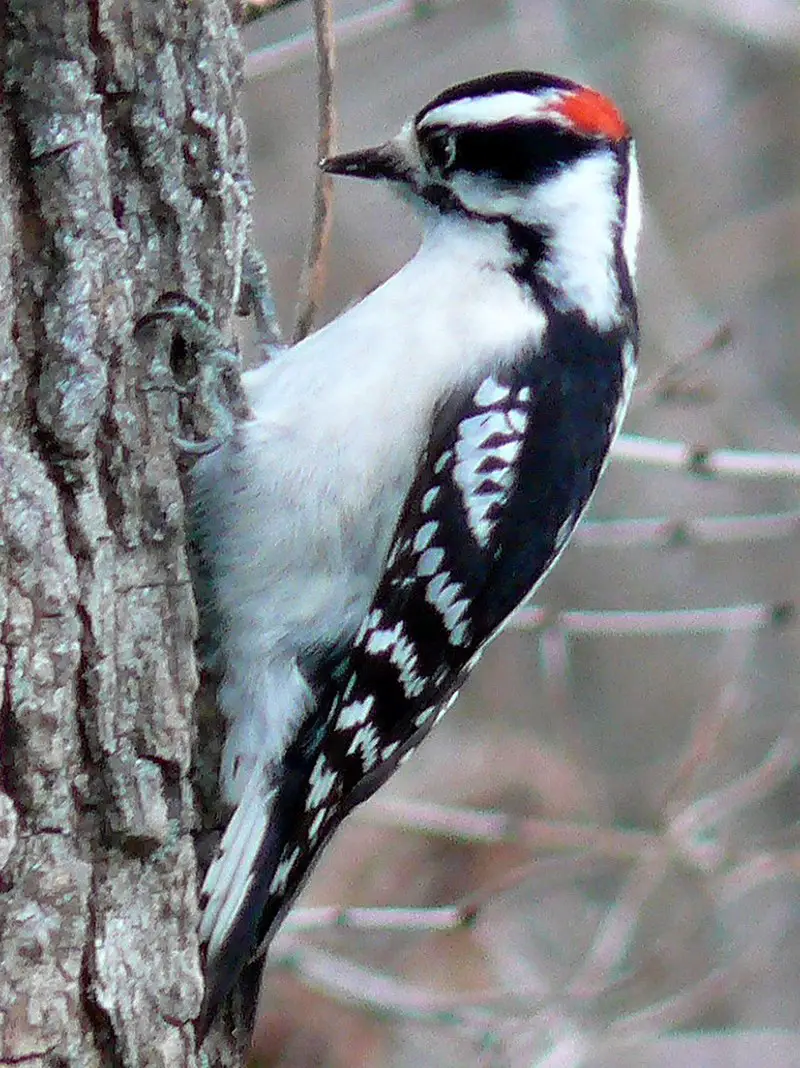
The downy woodpecker is a small species of woodpecker found in North America. Growing up to 7 inches long, it can be identified by its white belly and spotted wings.
It inhabits forests throughout the United States and Canada, with the exception of deserts in the southwest and northern tundra.
This bird nests in tree cavities and feeds mostly on insects but will supplement its diet with fruit or nuts when available.
The Downy Woodpecker has an unmistakable call that sounds like a loud ‘pik-er’, similar to other members of its family such as the Hairy Woodpecker.Scientific classification:
| Kingdom | Animalia |
| Phylum | Chordata |
| Class | Aves |
| Order | Piciformes |
| Family | Picidae |
| Genus | Dryobates |
| Species | D. pubescens |
8. Northern Mockingbird
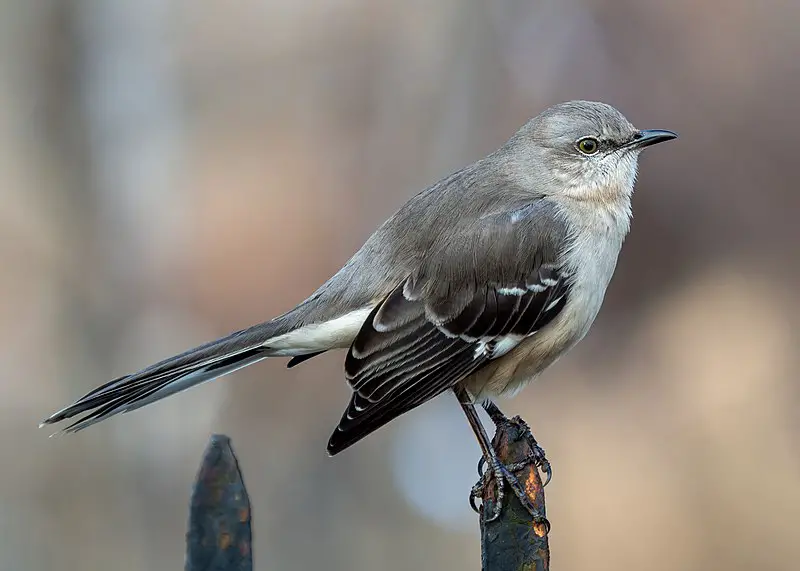
The northern mockingbird is a common fixture in North American skies. It has greyish-brown upperparts and a paler underside with white wing patches, and its distinctive long tail makes it easy to spot.
This adaptable bird can often be seen singing from the tops of trees or fences, though it rarely strays into Europe.
The species was first described by Carl Linnaeus in his 1758 Systema Naturae as Turdus polyglottos – aptly named for their remarkable ability to mimic other birds’ songs.
Northern mockingbirds typically live on insects, fruits, berries and seeds but they will also happily scavenge food scraps left out by humans.
With its beautiful song and striking plumage this beloved avian makes an important contribution to our environment.Scientific classification:
| Kingdom | Animalia |
| Phylum | Chordata |
| Class | Aves |
| Order | Passeriformes |
| Family | Mimidae |
| Genus | Mimus |
| Species | M. polyglottos |
9. Common Starling

The Common Starling is a medium-sized passerine bird that belongs to the starling family. It has glossy black plumage with a metallic sheen, and in certain times of year it can be speckled with white.
The bill and legs are typically pink or black depending on the season, while its length measures about 8 inches long.
Its diet consists mainly of insects but also includes small fruits and seeds as well as some human food waste.
They live in large flocks which provides protection against predators, although they can become quite aggressive when defending their nesting sites during breeding seasons.
Overall, this species is highly adaptable and widely distributed across many parts of Europe making them one of the most successful birds in the region today.Scientific classification:
| Kingdom | Animalia |
| Phylum | Chordata |
| Class | Aves |
| Order | Passeriformes |
| Family | Sturnidae |
| Genus | Sturnus |
| Species | S. vulgaris |
10. Song Sparrow
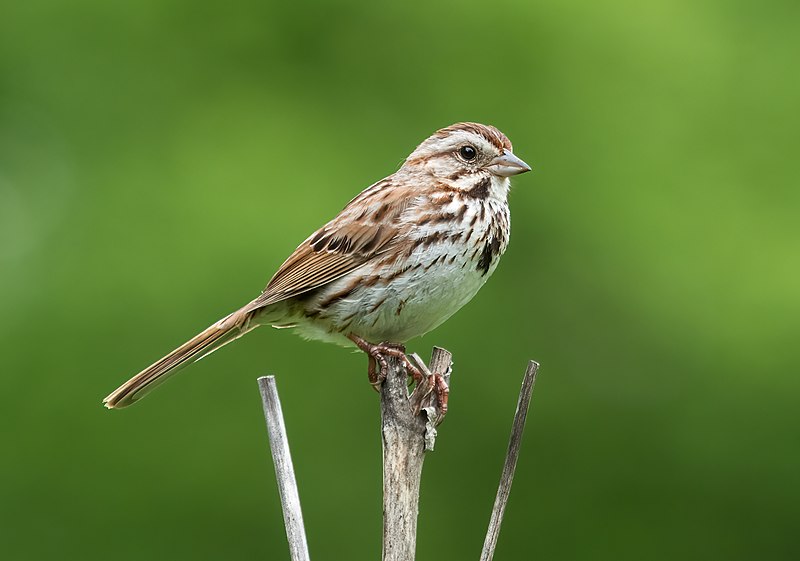
The Song Sparrow (Melospiza melodia) is a small, yet abundant bird found in North America.
They have brown upperparts with dark streaks and are white underneath, complete with a distinct dark brown spot on the breast.
Their cap is also brown and long roughed feathers can be seen sprouting from their neck area.
This sparrow species is highly variable and adaptable to many different environments including dry brush land, wetlands or open fields.
It has been noted that adult song sparrows will sing even during winter months when other birds remain quiet.
These energetic little animals make for great backyard companions as they flit about singing their lovely melodies.Scientific classification:
| Kingdom | Animalia |
| Phylum | Chordata |
| Class | Aves |
| Order | Passeriformes |
| Family | Passerellidae |
| Genus | Melospiza |
| Species | M. melodia |
11. Woodpeckers
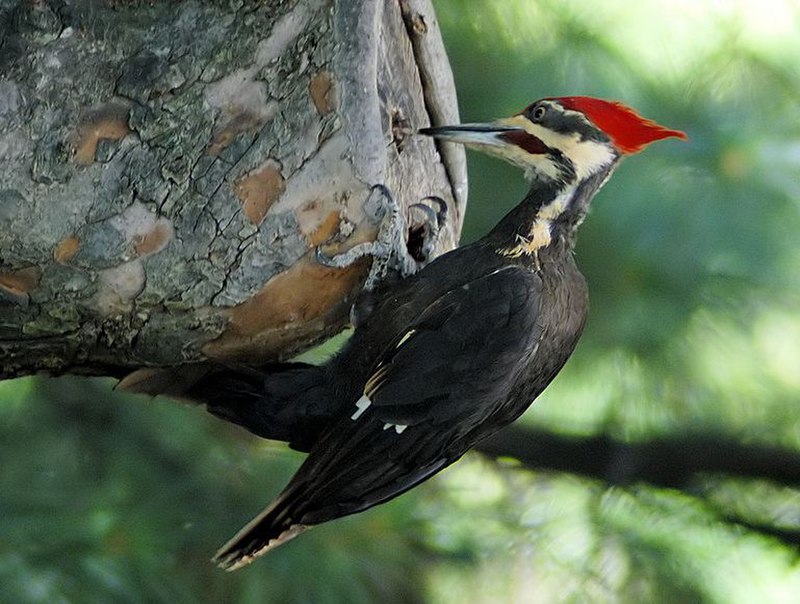
Woodpeckers are an incredibly diverse bird species, found all over the world except for Australia, New Guinea, New Zealand, Madagascar and the extreme polar regions.
They live in a variety of habitats including forests and woodlands but also rocky hillsides and deserts with no trees.
Their beaks are adapted to pecking at tree bark to find food such as insects or larvae hidden beneath it while they use their long tongues to catch them from deep inside crevices.
Woodpeckers have tough skulls that protect their brains from impact when they bang into things during drumming – a behaviour used by males for territorial signalling and reproduction purposes which is done using strong rapid beats against hollow objects like dead branches or metal poles.Scientific classification:
| Kingdom | Animalia |
| Phylum | Chordata |
| Class | Aves |
| Order | Piciformes |
| Infraorder | Picides |
| Family | Picidae Leach, 1820 |
12. White-Breasted Nuthatch
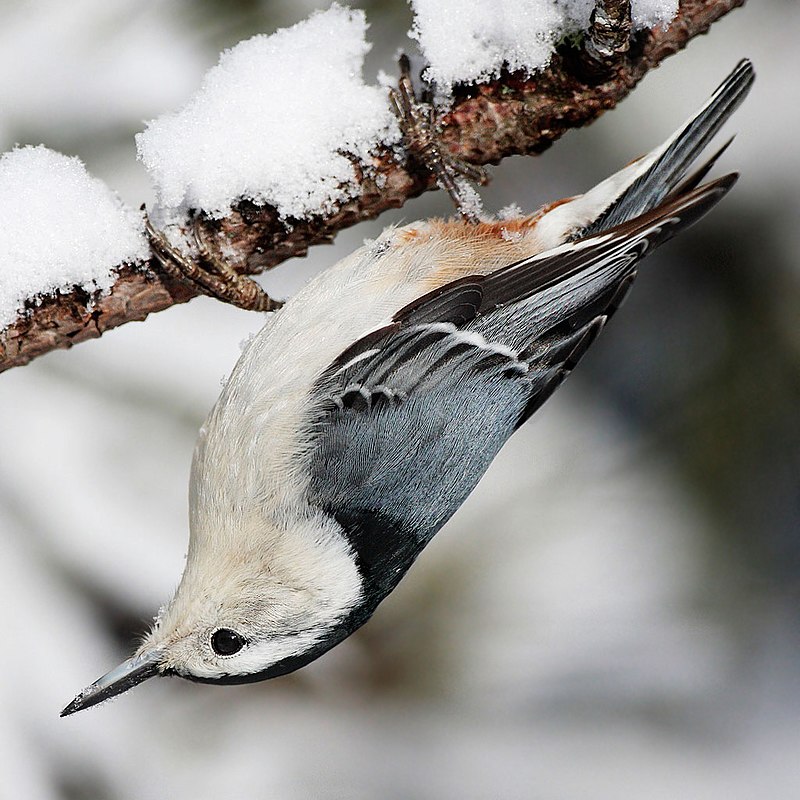
The White-breasted Nuthatch is a medium-sized bird belonging to the nuthatch family Sittidae. It measures around 15.5 cm in length and its colour varies throughout its range.
Males have a light blue-grey upperpart, with black crown and nape whereas females have a dark grey crown instead of black one.
The underparts are whitish, with reddish tinge on sides and flanks while the bill is short and stout with pale base near eyes which can be yellow or white depending upon geographic location..
This species feeds mainly on insects but will also eat seeds, nuts and berries when available.
They prefer open woodlands where they often climb trees searching for food along trunks as well as branches underneath bark crevices creating their nest there too.Scientific classification:
| Kingdom | Animalia |
| Phylum | Chordata |
| Class | Aves |
| Order | Passeriformes |
| Family | Sittidae |
| Genus | Sitta |
| Species | S. carolinensis |
13. Tit
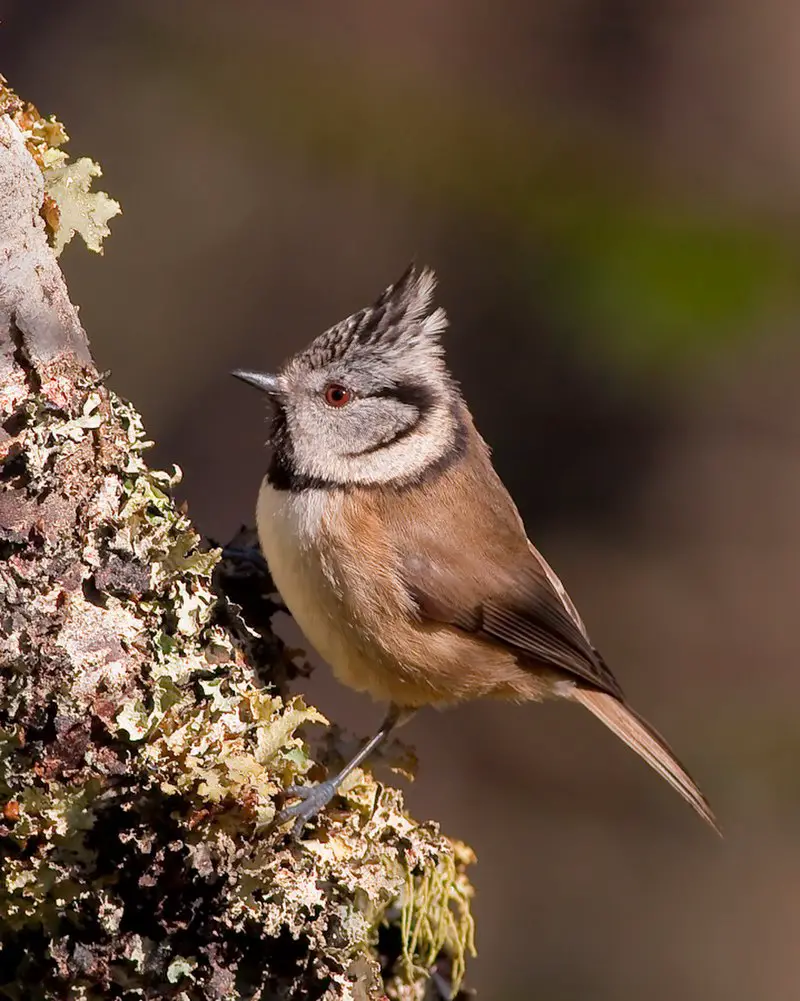
Tit birds are small passerine birds belonging to the family Paridae, found mainly in Northern Hemisphere and Africa.
These active little birds can be seen singing sweet songs throughout the day or scavenging for food at feeders.
They have short, stout bills which they use to crack open seeds and nuts with ease. Tit species range from chickadees to titmice; all of them sport a distinctive black head cap that stands out against their pale grey bodies.
Their bright eyes allow them excellent vision while searching for food – even on gloomy days when other predators may not see as well.
Tits are an important part of any healthy ecosystem and provide many ecological services such as insect control and seed dispersal.Scientific classification:
| Kingdom | Animalia |
| Phylum | Chordata |
| Class | Aves |
| Order | Passeriformes |
| Infraorder | Passerida |
| Family | Paridae Vigors, 1825 |
14. Red-Bellied Woodpecker
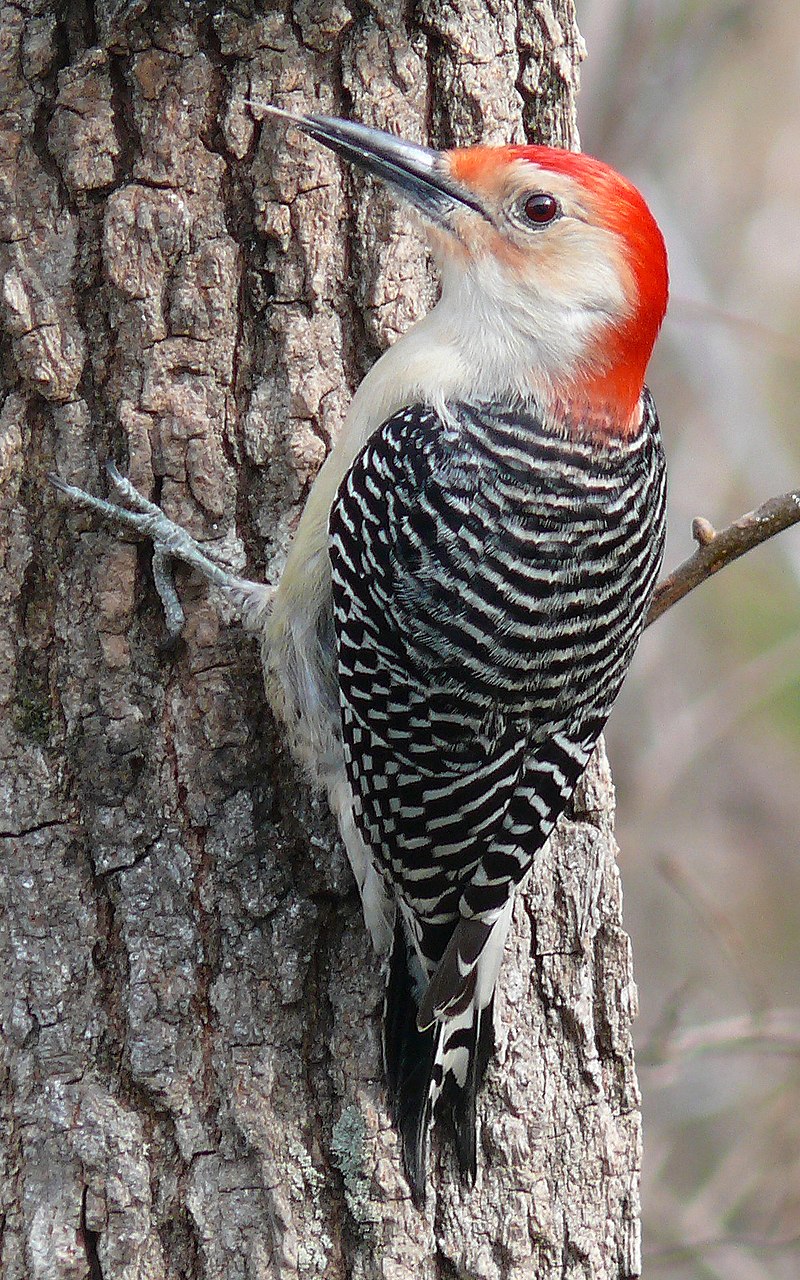
The Red-bellied woodpecker is a beautiful bird with an orange-red crown and nape. It breeds mainly in the eastern United States, ranging from Florida to Canada.
This medium-sized woodpecker of the family Picidae has black wings, white stripes on its back and tail feathers that are barred with black.
Its underside is mostly pale yellow or white but it also features some red coloration around its neck area.
Despite this subtle red hue, it should not be mistaken for the entirely red head and neck belonging to the Red-headed woodpecker of the same genus Melanerpes carolinus.
The Red bellied Woodpeckers diet consists primarily of insects such as ants, beetles and grasshoppers along with nuts fruits berries and tree sap which they will feed upon during different times throughout their life cycle.Scientific classification:
| Kingdom | Animalia |
| Phylum | Chordata |
| Class | Aves |
| Order | Piciformes |
| Family | Picidae |
| Genus | Melanerpes |
| Species | M. carolinus |
15. Dark-Eyed Junco

The Dark-eyed Junco is a species of small, grayish sparrows that are found across much of temperate North America and in the Arctic during summer.
It was formally described by Carl Linnaeus in 1766, who named it after its distinctive dark eyes.
This bird has a very variable appearance due to the many different subspecies it contains, making its systematics difficult to unravel.
The plumage varies from white or light gray on their underparts with slate grey backs and wings; black heads with white outer tail feathers; brown head stripes; yellow bills; pink legs and feet; as well as various shades between all these colours.
They also have considerable sexual dimorphism where males tend to be more colourful than females but share similar characteristics such as short tails and rounded bodies – both sexes being around 16 cm long when fully grown.Scientific classification:
| Kingdom | Animalia |
| Phylum | Chordata |
| Class | Aves |
| Order | Passeriformes |
| Family | Passerellidae |
| Genus | Junco |
| Species | J. hyemalis |
16. American Crow
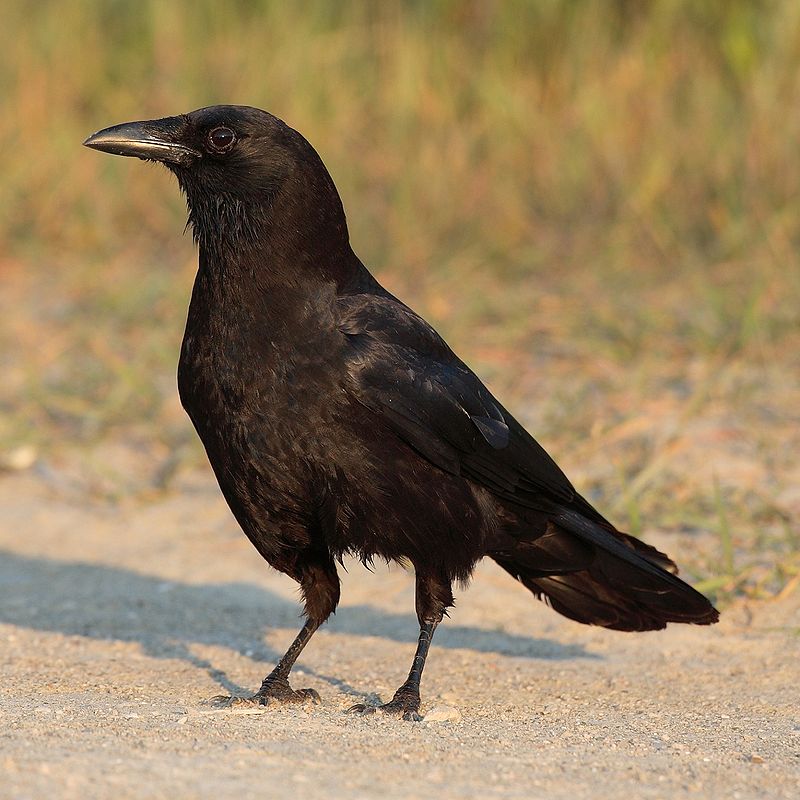
The American crow is a large bird of the Corvidae family, native to most parts of North America.
It is similar in size and structure to its European counterpart, the carrion crow, as well as Eurasia’s hooded crow.
The three species occupy the same ecological niche, but are distinguishable by their differences in appearance.
American crows have black feathers covering their entire body with wingspan averaging between 17-21 inches wide for males and 16-19 inches for females.
They feed on insects such as grasshoppers, beetles and caterpillars; they also eat grains from fields or abandoned farms during winter months when food sources become scarcer.
In addition to feeding habits American crows can be identified by their distinct call which resembles a “caw” sound that travels long distances over open terrain making them popular among birdwatchers.Scientific classification:
| Kingdom | Animalia |
| Phylum | Chordata |
| Class | Aves |
| Order | Passeriformes |
| Family | Corvidae |
| Genus | Corvus |
| Species | C. brachyrhynchos |
17. White-Throated Sparrow
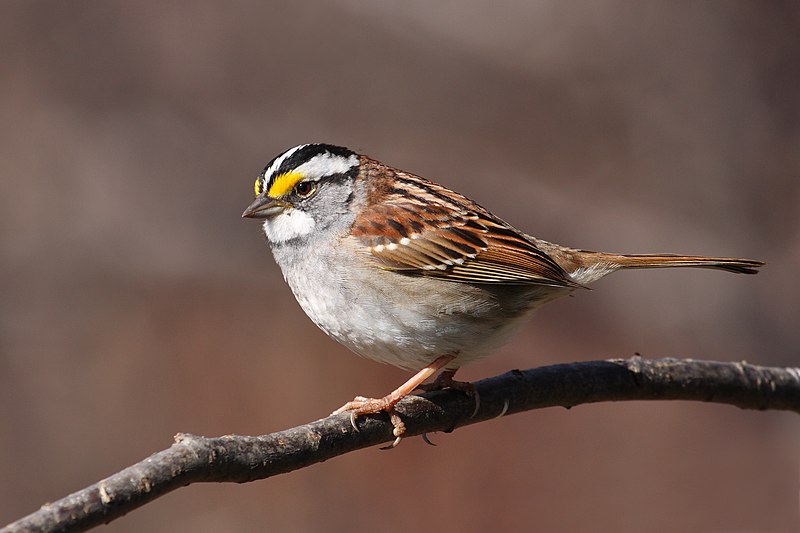
The White-throated Sparrow is a small passerine bird of the New World sparrow family Passerellidae.
It has distinctive yellow and black stripes on its head, white throat and chest with grey back and wings, along with light brown legs.
The scientific name “Zonotrichia albicollis” comes from Ancient Greek for ‘band’ (ζώνη) referring to its distinctive striped crown, and Latin for ‘white neck’ (albus collum).
These birds are usually found in wooded areas such as coniferous forests or deciduous habitats in North America where they feed mainly on insects during summer months; transitioning to seeds during winter.
They build their nests near ground level using grasses, twigs or moss lined with feathers.
White-throated Sparrows may be solitary but also form flocks when migrating southward each fall season which typically occurs over mid-late October through November depending on location within range.Scientific classification:
| Kingdom | Animalia |
| Phylum | Chordata |
| Class | Aves |
| Order | Passeriformes |
| Family | Passerellidae |
| Genus | Zonotrichia |
| Species | Z. albicollis |
18. Mourning Dove
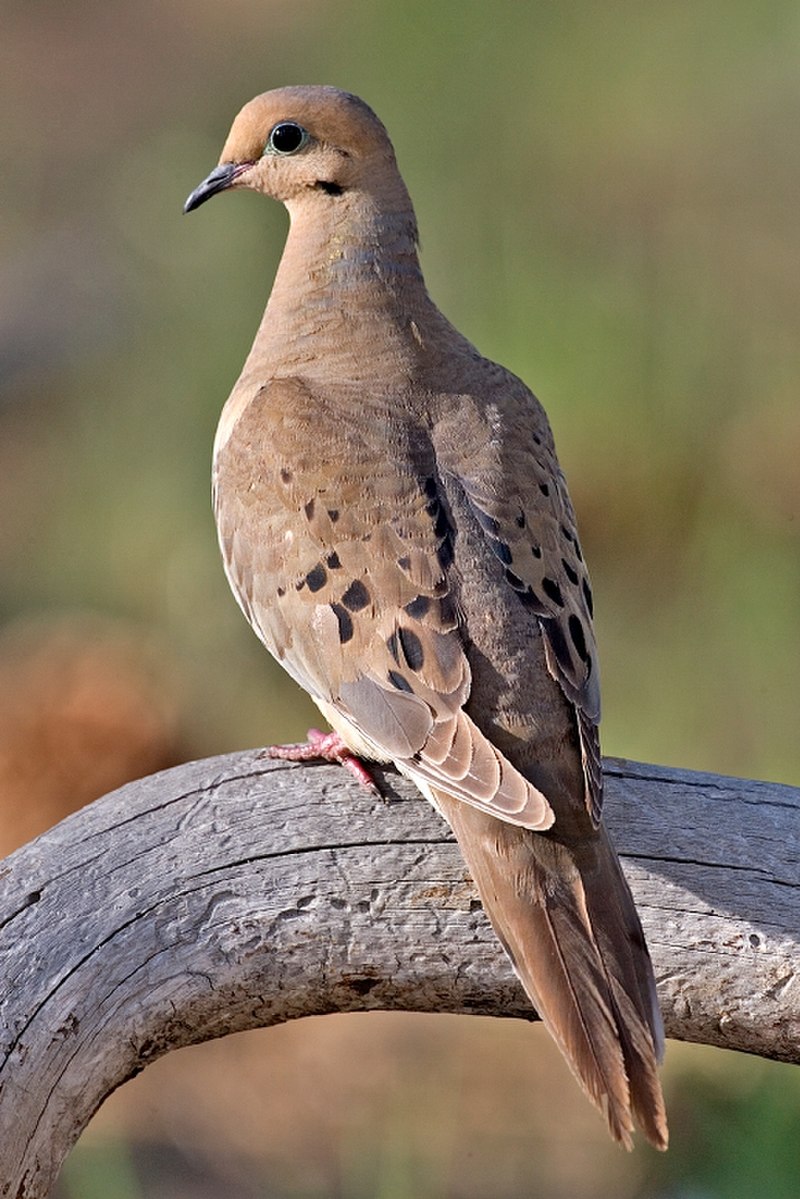
The Mourning Dove is a breathtakingly beautiful bird. It has stunning gray and brown feathers with white tipped wings, giving it an elegant appearance. Its long tail also adds to its graceful look in flight.
A symbol of peace and serenity, they are abundant across North America and can be found in gardens or open fields throughout the year.
As well as being popular game birds for hunters, they feed on grains such as wheat and millet providing important food sources for wildlife species including foxes, coyotes, skunks and raccoons.
These doves have a distinctive cooing sound that can often be heard echoing through woodlands during summer evenings making them one of nature’s greatest treasures.Scientific classification:
| Kingdom | Animalia |
| Phylum | Chordata |
| Class | Aves |
| Order | Columbiformes |
| Family | Columbidae |
| Genus | Zenaida |
| Species | Z. macroura |
19. Eastern Bluebird
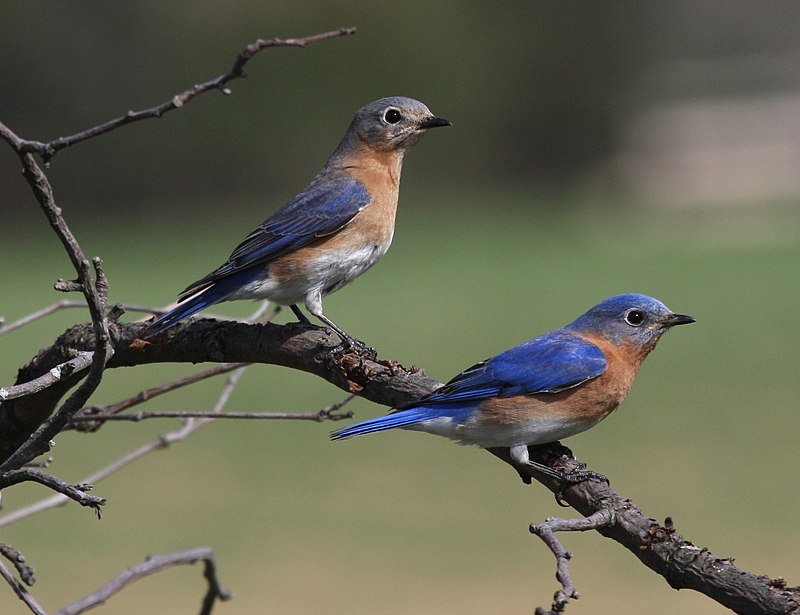
The Eastern bluebird is a small migratory thrush that can be found in open woodlands, farms and orchards across North America.
The male has bright-blue breeding plumage which makes it easily recognizable by birders.
It produces melodious songs such as jeew, chir-wi and chiti WEEW wewidoo.
This popular species was declared the state bird of Missouri back in 1927 due to its beauty and charm.
In addition to being beautiful, these birds are also beneficial for farmers because they eat insects like grasshoppers and beetles which damage crops.
They nest in cavities so providing nesting boxes helps them thrive even more.
With their vibrant colors, sweet melodies and helpful nature it’s easy to see why the Eastern Bluebird is beloved worldwide.Scientific classification:
| Kingdom | Animalia |
| Phylum | Chordata |
| Class | Aves |
| Order | Passeriformes |
| Family | Turdidae |
| Genus | Sialia |
| Species | S. sialis |
20. Common Grackle
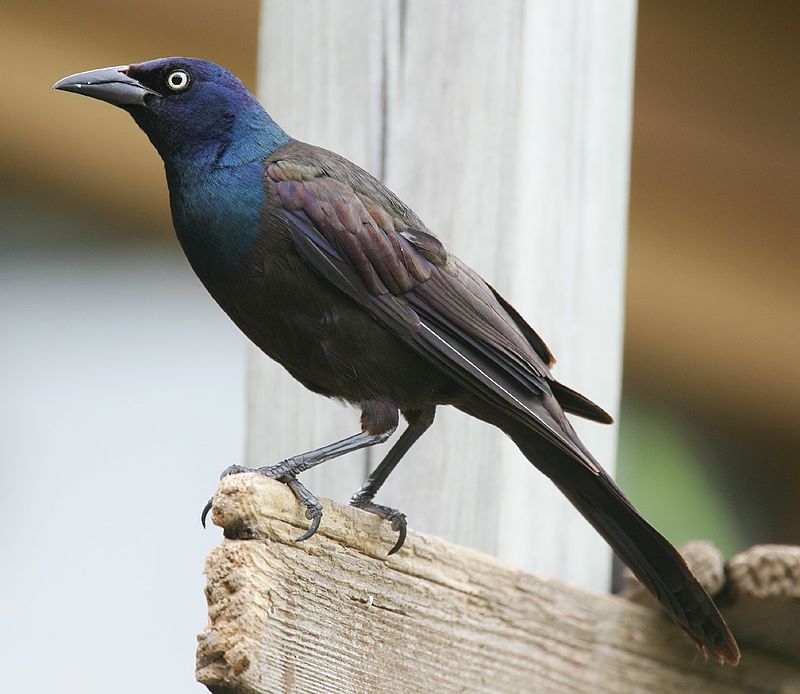
The Common Grackle is a large icterid bird commonly found in North America. It has an iridescent head and pale yellow eyes, which are framed by its long dark bill and long tail.
Males typically have more vivid colors on their heads than females do. These birds can be seen across much of the continent, in fields, forests, wetlands – even urban areas.
They form huge flocks to search for food such as grains or insects that they catch with their bills.
The grackles may also scavenge from human sources like garbage dumps or picnic tables if available. With its colorful plumage and distinct call it’s easy to spot this species amongst other birds.Scientific classification:
| Kingdom | Animalia |
| Phylum | Chordata |
| Class | Aves |
| Order | Passeriformes |
| Family | Icteridae |
| Genus | Quiscalus |
| Species | Q. quiscula |
21. Carolina Chickadee
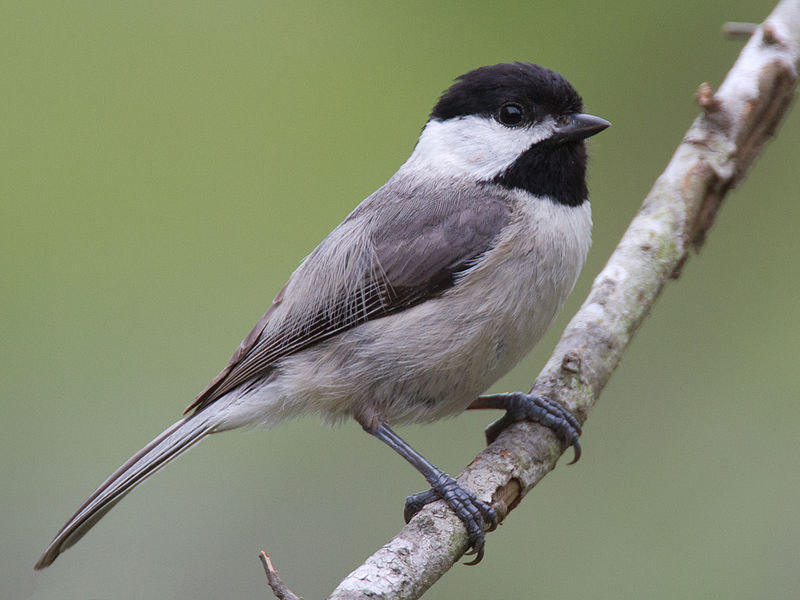
The Carolina Chickadee is a small passerine bird found in the tit family Paridae. It stands out for its distinct black and white, grey-brown feathers with an offwhite underside.
This species can be spotted by its call: “chick-a-dee”. The American Ornithologists’ Union has classified them into their own genus called Poecile as they differ from other tits due to both genetic data and morphology.
These birds are found all over North America, living in wooded areas near open fields or water sources.
They feed on insects such as caterpillars but also have been known to eat suet at backyard feeders during winter months when food is scarce.Scientific classification:
| Kingdom | Animalia |
| Phylum | Chordata |
| Class | Aves |
| Order | Passeriformes |
| Family | Paridae |
| Genus | Poecile |
| Species | P. carolinensis |
22. Barn Swallow
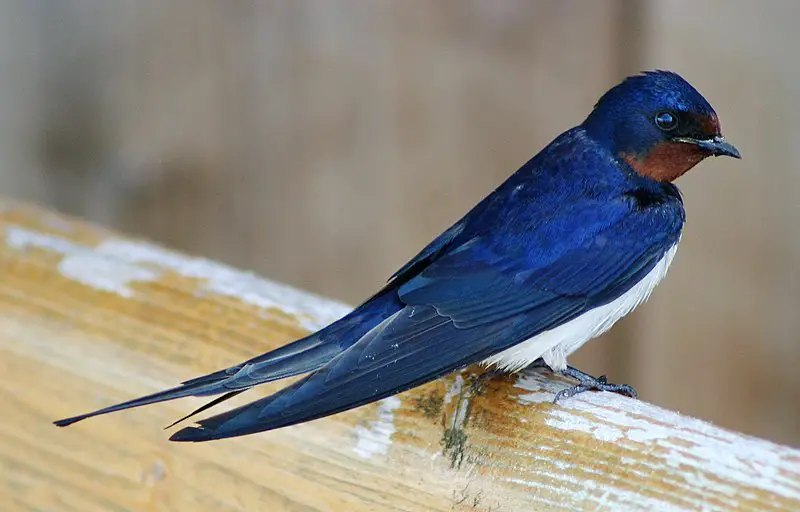
The Barn Swallow is a beautiful passerine bird with blue upperparts and a long, deeply forked tail. Found in Europe, Asia, Africa and the Americas.
It has an astonishingly large natural distribution spanning 251 million square kilometres globally; likely making it one of the world’s most widespread species.
This swallow typically nests near human habitation as well as other open areas such as fields or grasslands which provide them with suitable invertebrate prey to feed on.
They are insectivorous birds that often fly together in flocks looking for food over rivers or marshes usually just above tree-top level.
The barn swallow can also be identified by its strong flight consisting of swift continuous wing beats interspersed with glides during which they hold their wings slightly raised at the shoulders giving them distinct V shaped silhouettes in the sky.Scientific classification:
| Kingdom | Animalia |
| Phylum | Chordata |
| Class | Aves |
| Order | Passeriformes |
| Family | Hirundinidae |
| Genus | Hirundo |
| Species | H. rustica |
23. New World Warblers
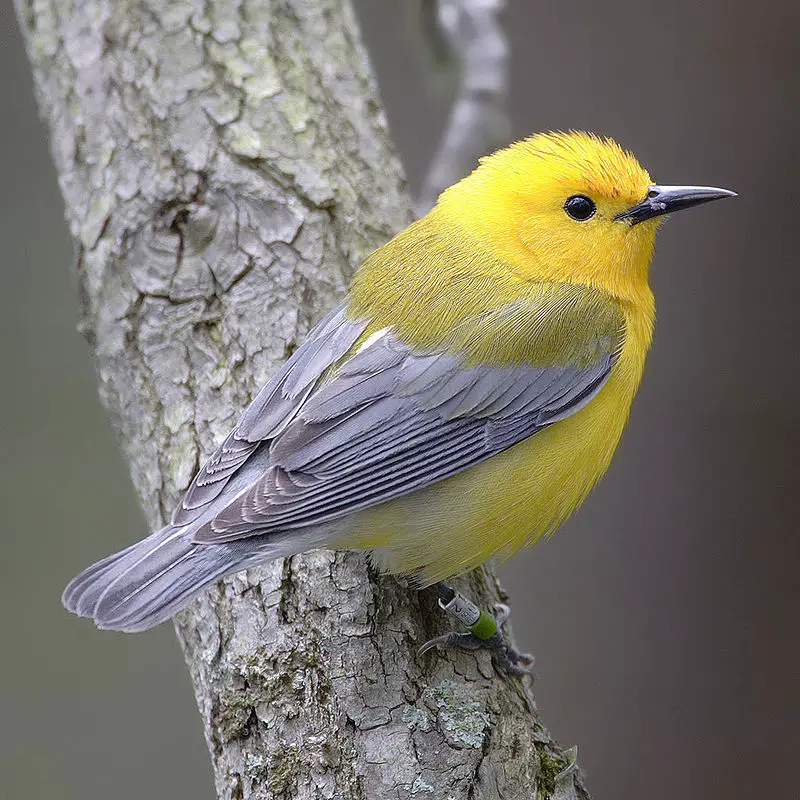
New World warblers are an incredibly diverse family of small birds found only in the Americas. They range in size from tiny hummingbirds to large thrushes, and come in a variety of vibrant colors.
All have thin bills made for eating insects which form their main diet. Most species live predominantly arboreal lives, meaning they spend most of their time among trees or bushes searching for food.
However some members such as ovenbirds and waterthrushes prefer more terrestrial habitats like forest floors where they can scavenge for bugs on the ground instead.
Warblers provide a great source of entertainment with their beautiful songs often filling up woodlands during mornings and evenings throughout springtime.Scientific classification:
| Kingdom | Animalia |
| Phylum | Chordata |
| Class | Aves |
| Order | Passeriformes |
| Superfamily | Emberizoidea |
| Family | Parulidae Wetmore et al., 1947 |
24. Bluebirds
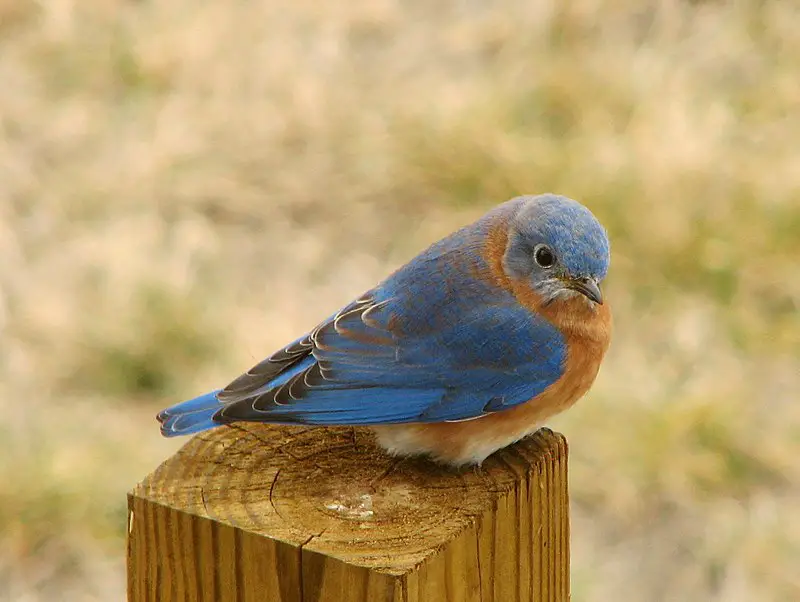
Bluebirds are a North American species of small to medium-sized birds belonging to the thrush family. They have stunning blue and rose beige plumage, with males having brighter colors than females.
These beautiful birds mainly feed on insects, but they can also eat some fruits or seeds from time to time. Bluebirds reside in open fields, meadows and backyards across much of North America.
Their cheerful songs bring joy as they fly through their habitats looking for food during the day before returning home at nightfall.
The sight of these beautiful creatures is often associated with happiness and hope – making them beloved by many people.Scientific classification:
| Kingdom | Animalia |
| Phylum | Chordata |
| Class | Aves |
| Order | Passeriformes |
| Family | Turdidae |
| Subfamily | Myadestinae |
| Genus | Sialia Swainson, 1827 |
25. Carolina Wren
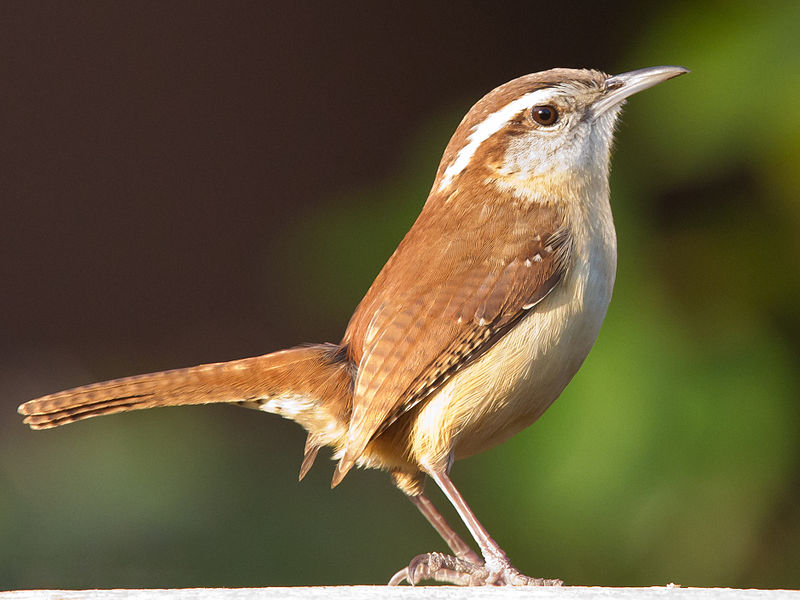
The Carolina wren (Thryothorus ludovicianus) is a medium-sized bird that can be found in the eastern United States, southern Ontario and northeast Mexico.
They typically live in dense shrubbery or thickets near open areas such as gardens, parks and woodland edges.
These birds are quite adaptable when it comes to nesting sites – they will build their nests anywhere from tree cavities to manmade boxes.
Their diet consists of insects, spiders and other invertebrates which they forage for on the ground or among vegetation.
The males have an unmistakable song made up of loud whistles interspersed with trills reminiscent of laughter; you’ll often find these cheerful little birds singing away during early morning hours.Scientific classification:
| Kingdom | Animalia |
| Phylum | Chordata |
| Class | Aves |
| Order | Passeriformes |
| Family | Troglodytidae |
| Genus | Thryothorus Vieillot, 1816[2] |
| Species | T. ludovicianus |
26. Red-Winged Blackbird

The red-winged blackbird is a beautiful bird found in most of North America and Central America.
Its distinct features include a glossy black body, with white shoulder patches and bright red wing coverts year round.
It prefers wetland habitats such as marshes, ponds, lakeshores and agricultural fields. During breeding season they inhabit grassy areas near water then move south for the winter months.
For food they mainly eat insects but also consume wild fruit or grains.
They are very social birds often seen in large flocks during migration times when their unmistakable “conk-la-ree” call can be heard echoing across the sky.Scientific classification:
| Kingdom | Animalia |
| Phylum | Chordata |
| Class | Aves |
| Order | Passeriformes |
| Family | Icteridae |
| Genus | Agelaius |
| Species | A. phoeniceus |
27. Purple Finch
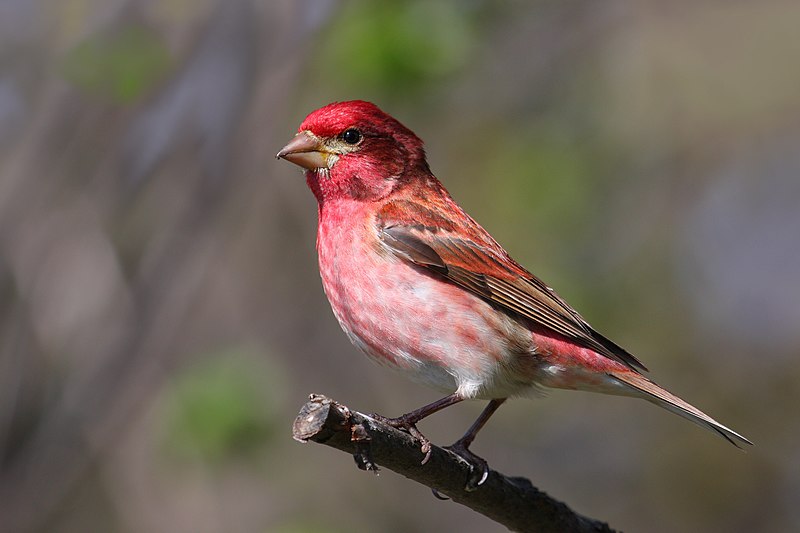
The Purple Finch is a species of finch from North America, belonging to the Fringillidae family.
It’s also known as an “American Rosefinch” due to its resemblance in color and size to some European rosefinches.
Their plumage ranges from pinkish-purple on their heads and wings, with a light brown underside.
They are small birds that measure about 5-6 inches long with short thin beaks for eating seeds and insects.
In addition, they have thick round bodies which help them stay warm during cold winters in the northern parts of their range.
The Purple Finch has adapted well over time making it easier for them to survive even though there are increasing threats posed by humans such as deforestation or habitat destruction caused by development projects near their habitats.Scientific classification:
| Kingdom | Animalia |
| Phylum | Chordata |
| Class | Aves |
| Order | Passeriformes |
| Family | Fringillidae |
| Subfamily | Carduelinae |
| Genus | Haemorhous |
| Species | H. purpureus |
28. Eastern Towhee

The Eastern Towhee is a large New World sparrow, native to brushy areas of eastern North America. These birds have distinct black and white markings, with chestnut brown underparts.
They nest either low in bushes or on the ground beneath shrubs. Northern towhees are known for migrating south during the winter months.
In recent decades, taxonomy debates have left some questioning whether this bird should remain its own species or be grouped together with the Spotted Towhee as one species — Rufous-sided Towhee.
This lively songbird has a bubbly personality and can often be seen hopping around on branches looking for food such as insects, fruits and seeds.Scientific classification:
| Kingdom | Animalia |
| Phylum | Chordata |
| Class | Aves |
| Order | Passeriformes |
| Family | Passerellidae |
| Genus | Pipilo |
| Species | P. erythrophthalmus |
29. Gray Catbird
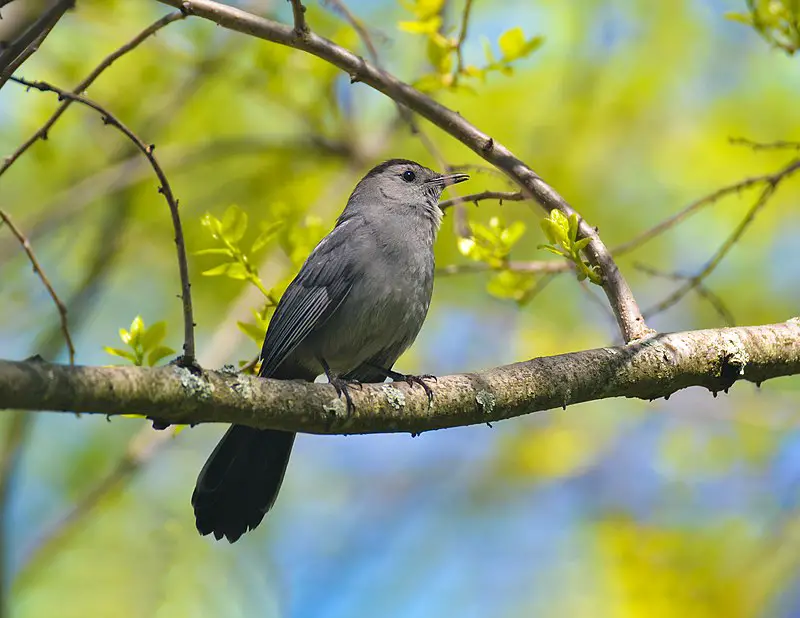
The Gray Catbird is a medium-sized bird native to North and Central America. It is the only species in its genus, Dumetella, which makes it unique among other perching birds of the Mimidae family.
Its plumage features shades of gray with some brownish tones on top and lighter grey below.
The underside of its tail has white feathers that contrast against their otherwise monochromatic coloration; this feature gives them their name as they often flick their tails when alarmed or excited like cats do.
They are omnivorous but mainly feed on insects such as caterpillars, grasshoppers, and beetles while also eating fruits like berries or cherries during summer months.
Despite being commonly seen alone or in pairs these birds will flock together at times for protection from predators like hawks who are drawn to their dark colouration against green foliage making them harder to spot.Scientific classification:
| Kingdom | Animalia |
| Phylum | Chordata |
| Class | Aves |
| Order | Passeriformes |
| Family | Mimidae |
| Genus | Dumetella C.T. Wood, 1837 |
| Species | D. carolinensis |
30. Virginia Rail
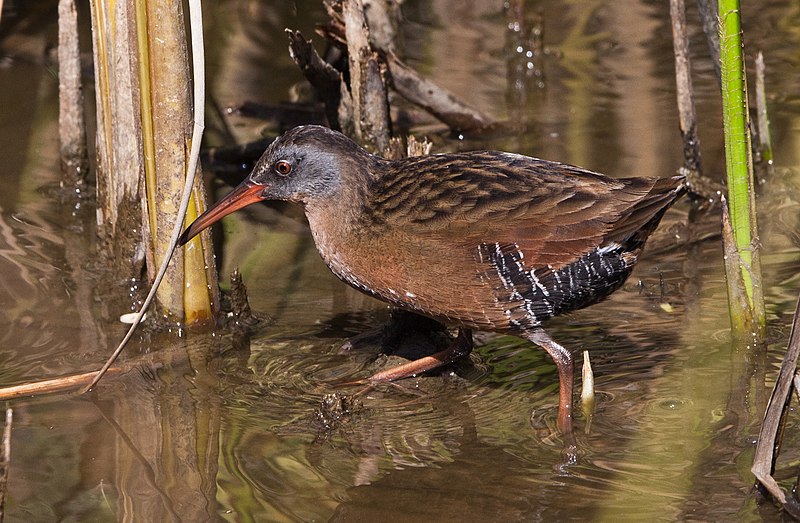
The Virginia Rail is a small waterbird which belongs to the Rallidae family. It remains fairly common in spite of habitat loss, but it’s difficult to spot since they tend to be quite secretive and their calls can often be heard more than them being seen.
They are also sometimes hunted for sport, however this does not happen very often. The Ecuadorian rail is considered by some authorities as its own species separate from the Virginia Rail, although others classify it as a subspecies.
These birds have dull coloured plumage with brownish-grey upperparts and whitish underparts; males have a reddish throat patch during breeding season while females do not possess one at all times.Scientific classification:
| Kingdom | Animalia |
| Phylum | Chordata |
| Class | Aves |
| Order | Gruiformes |
| Family | Rallidae |
| Genus | Rallus |
| Species | R. limicola |
Also Featured In: Common Central Park Birds, Wetlands Birds You Should Know
31. Scarlet Tanager
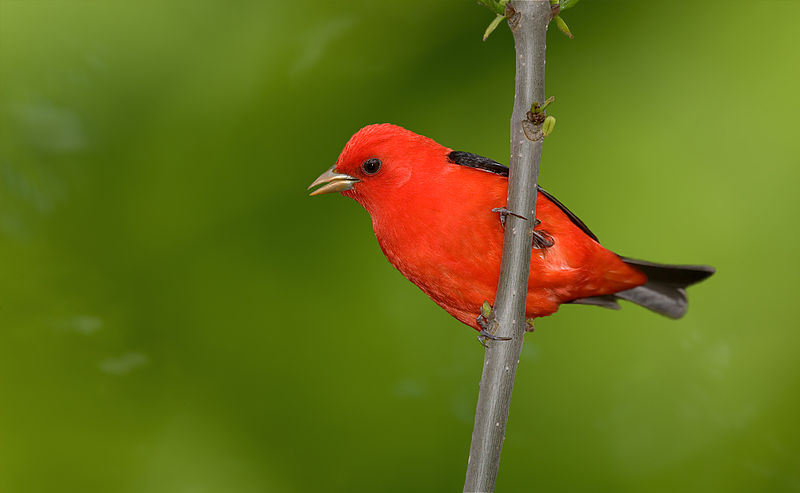
The Scarlet Tanager is a beautiful medium-sized bird found in parts of North and South America. It belongs to the Cardinal family, and has striking red plumage with black wings and tail feathers.
Its song is similar to other cardinals yet also unique in its own way – it’s recognizable by its high whistles that become lower towards the end.
The species feeds mainly on insects as well as berries from trees or shrubs during breeding season, when they may form loose flocks over open woodlands foraging for food.
They are highly territorial birds during nesting season which happens between April and June each year; both males and females fiercely defend their nests against intruders such as cats or squirrels.Scientific classification:
| Kingdom | Animalia |
| Phylum | Chordata |
| Class | Aves |
| Order | Passeriformes |
| Family | Cardinalidae |
| Genus | Piranga |
| Species | P. olivacea |
32. American Redstart
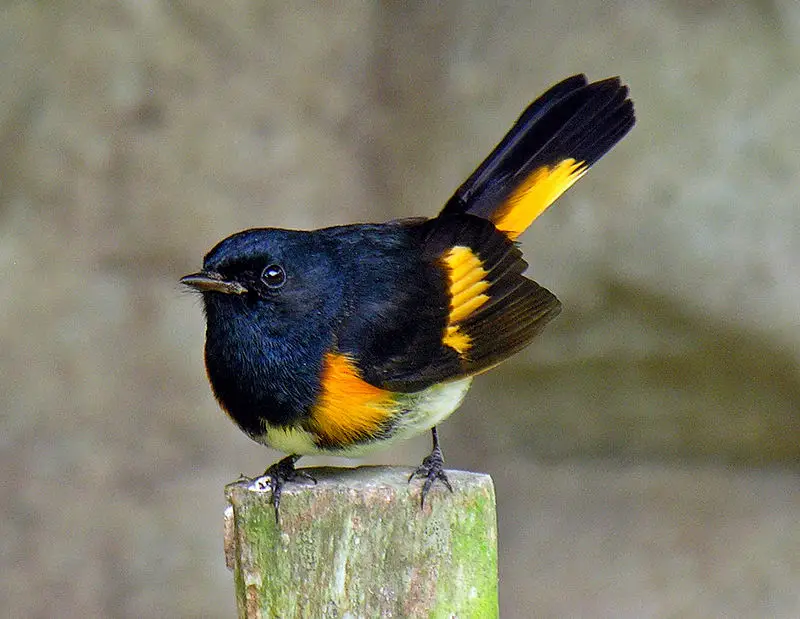
The American Redstart is a beautiful New World Warbler, first documented by Carl Linnaeus in 1758.
It has an elegant black and orange plumage that sets it apart from other birds.
The genus name Setophaga comes from the Ancient Greek words ‘sēs’ meaning moth and ‘phagos’, which means eating – referencing its insect-eating habits.
Its song is one of joy, with short repeating phrases making up their melodic tune.
They are mostly found hopping around trees on their long legs during breeding season but migrate to Central America for winter months when food sources become scarce in North America.Scientific classification:
| Kingdom | Animalia |
| Phylum | Chordata |
| Class | Aves |
| Order | Passeriformes |
| Family | Parulidae |
| Genus | Setophaga |
| Species | S. ruticilla |
33. Tree Swallow
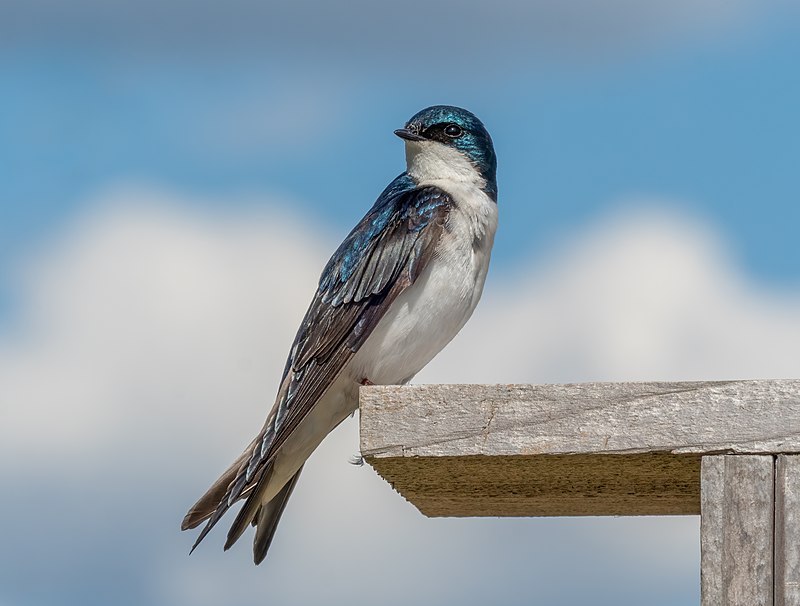
The Tree Swallow is a migratory bird of the Hirundinidae family, first described by French ornithologist Louis Vieillot in 1807. It has glossy blue-green upperparts, and white underparts with iridescent violet on its throat and breast.
Its wings are blackish above with pale grey below, while its tail feathers are blackish-blue with white edges.
During breeding season they build cup shaped nests out of grasses or twigs which are lined with animal hair or fur found near their nesting sites.
They feed mainly on insects such as flies and beetles that they catch while flying over fields or water surfaces during summer months when food is abundant for them to survive migration back southward in winter time.
The tree swallow is an important part of our environment both aesthetically and ecologically due to it’s insectivorous diet helping keep pest populations low in certain areas where agricultural crops may otherwise be damaged without these birds around.Scientific classification:
| Kingdom | Animalia |
| Phylum | Chordata |
| Class | Aves |
| Order | Passeriformes |
| Family | Hirundinidae |
| Genus | Tachycineta |
| Species | T. bicolor |
34. Baltimore Oriole
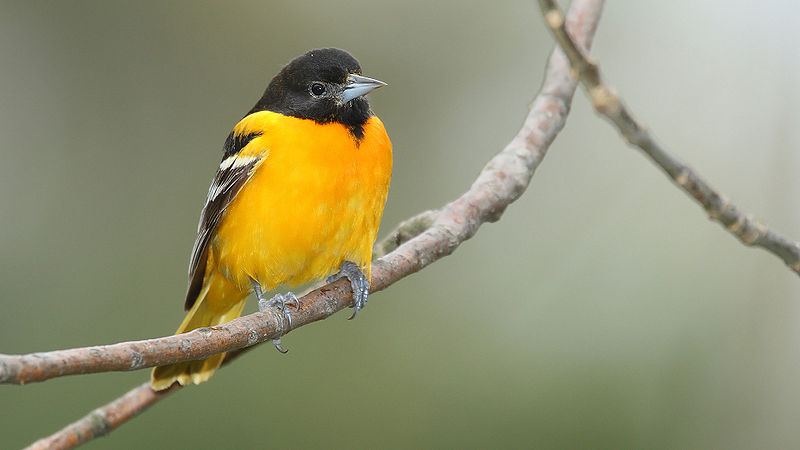
The Baltimore Oriole is a small, blackbird-like bird found in eastern North America. It’s named for the resemblance of its male colors to those on Lord Baltimore’s coat-of-arms from 17th century.
These birds migrate and breed during springtime and are quite common in their habitats.
Studies have shown that this species interbreeds with western Bullock’s orioles, leading both to be classified as a single species – Icterus galbula.
The males typically have orange feathers along the chest, back, wings and tail while females display tan or yellowish shades instead of bright orange ones like males do.
Both sexes share white wing bars and dark brown eyes which makes them easily distinguishable among other birds.
They can often be seen flitting around trees feeding off nectar buds or insects such as grasshoppers & caterpillars they catch while flying around.Scientific classification:
| Kingdom | Animalia |
| Phylum | Chordata |
| Class | Aves |
| Order | Passeriformes |
| Family | Icteridae |
| Genus | Icterus |
| Species | I. galbula |
35. Cooper’s Hawk
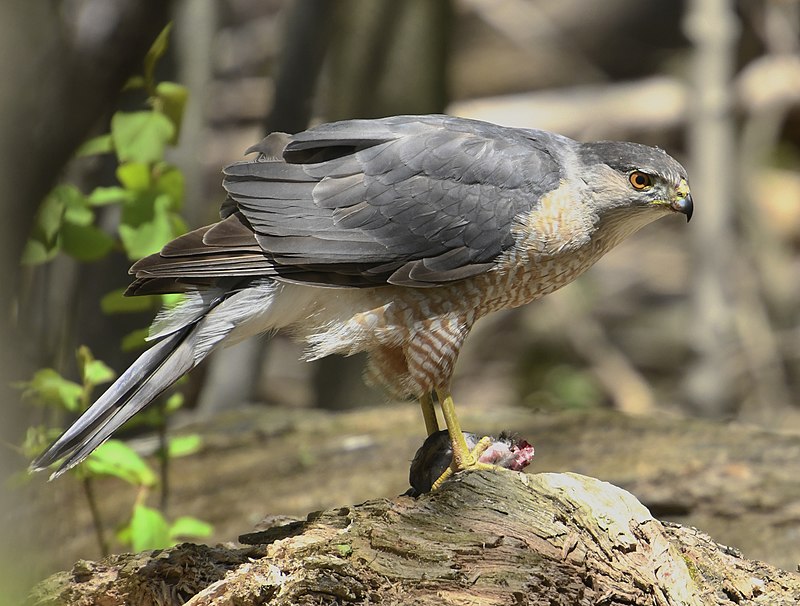
Cooper’s Hawk is a medium-sized bird of prey native to North America. It belongs to the Accipiter genus, which are known for their agility and small size compared to other hawks.
They usually inhabit wooded areas, making them well-adapted hunters in dense environments.
Cooper’s Hawks have rounded wings with short tails that help them maneuver quickly through trees when chasing after prey such as small rodents or birds.
These raptors also possess powerful feet equipped with sharp talons used for catching food items on the ground and even out of midair.
The adult plumage has barred upperparts, ranging from greyish brown on lighter individuals up to dark chestnut colors found in darker specimens; they also display rusty underparts marked by thin white streaking down either side of their chests and bellies.Scientific classification:
| Kingdom | Animalia |
| Phylum | Chordata |
| Class | Aves |
| Order | Accipitriformes |
| Family | Accipitridae |
| Genus | Accipiter |
| Species | A. cooperii |
36. Eastern Screech Owl
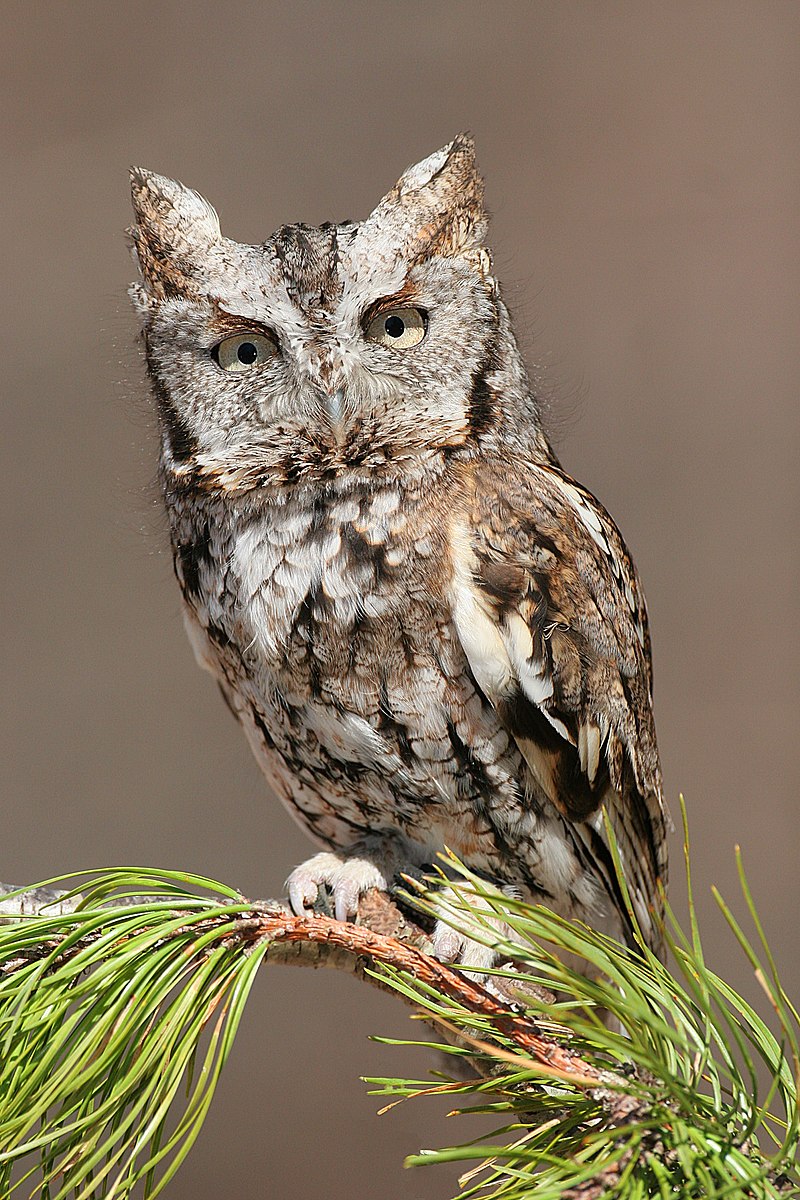
The Eastern screech owl is a small nocturnal bird native to most wooded areas in Mexico and Canada. It has adapted well to human development, making it relatively common in East North America.
This species is known for its unique call which often sounds like a horse whinnying or an electronic beep.
Its feathers are mainly grey with brown bars, but they can also range from red-brown to blackish-grey depending on the individual bird’s location.
They feed primarily on insects and other small animals such as mice and lizards that live near their nest sites at night.
The eastern screech owl is an amazing creature adapting well to humans while still managing to stay hidden under cover of darkness.Scientific classification:
| Kingdom | Animalia |
| Phylum | Chordata |
| Class | Aves |
| Order | Strigiformes |
| Family | Strigidae |
| Genus | Megascops |
| Species | M. asio |
37. Great Blue Heron
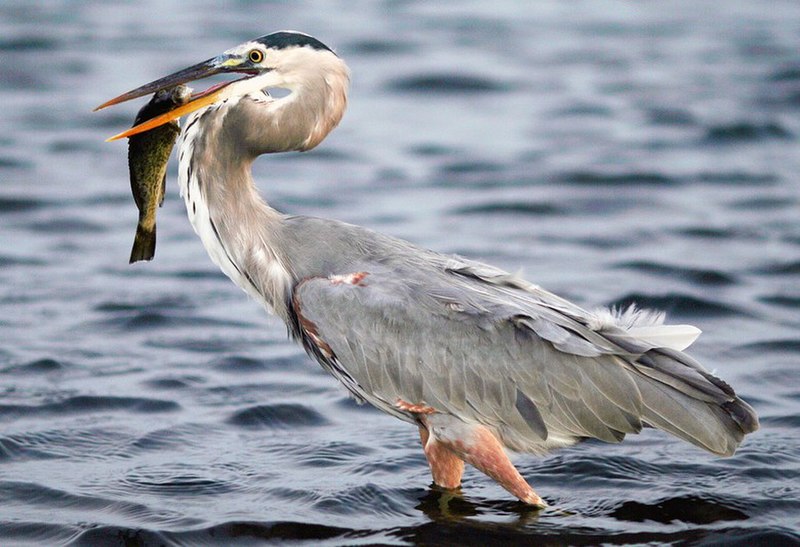
The Great Blue Heron is a majestic wading bird found in many parts of North America, Central America, the Caribbean and even as far away as the Galapagos Islands.
It has an impressive wingspan which can reach up to six feet wide. Its feathers are mainly bluish-gray with brownish streaks on both its neck and chest while its head displays white plumes.
The adult herons can also be identified by their yellow bill and legs.
They live near bodies of water such as lakes, marshes or rivers where they feed on fish using a spear like motion with their sharp bills.
An all-white population exists only in south Florida and the Florida Keys making it quite unique.Scientific classification:
| Kingdom | Animalia |
| Phylum | Chordata |
| Class | Aves |
| Order | Pelecaniformes |
| Family | Ardeidae |
| Genus | Ardea |
| Species | A. herodias |
38. Ruby-Throated Hummingbird
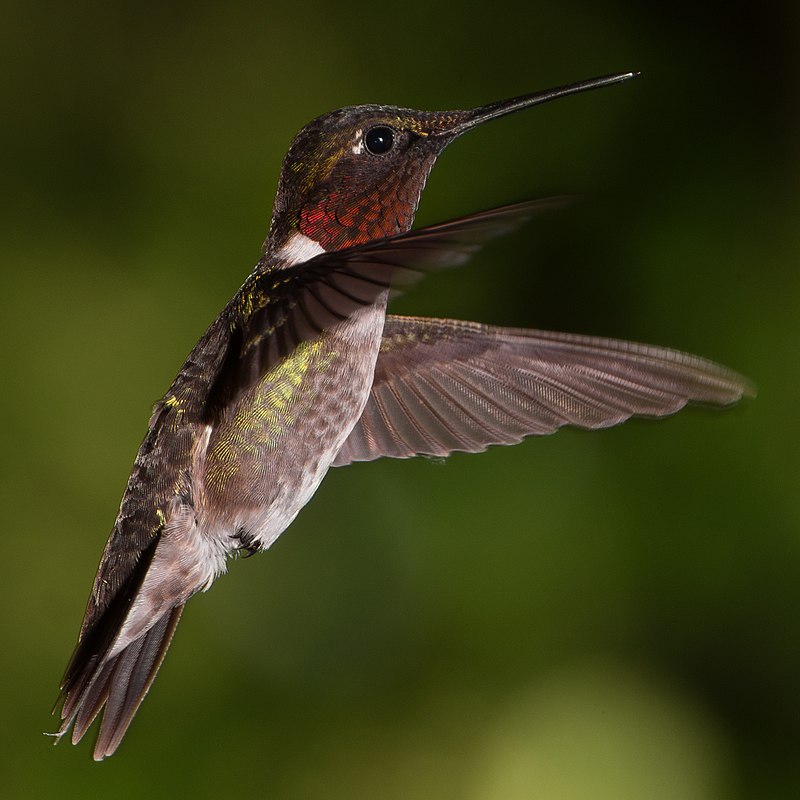
The ruby-throated hummingbird (Archilochus colubris) is a species of hummingbird that has an impressive migration pattern, spending the winter in Central America, Mexico and Florida before flying to Canada and other parts of Eastern North America for breeding season.
It’s by far the most common type seen east of the Mississippi River in North America.
Formally described by Swedish naturalist Carl Linnaeus in 1758, this tiny bird has bright metallic green upperparts with white underparts, a small black bill and a red throat patch which gives it its name; they measure around 3 inches long on average.
They feed primarily on nectar from flowers but also eat insects such as flies or mosquitoes for extra protein during their migrations or when raising young chicks.Scientific classification:
| Kingdom | Animalia |
| Phylum | Chordata |
| Class | Aves |
| Order | Apodiformes |
| Family | Trochilidae |
| Genus | Archilochus |
| Species | A. colubris |
39. Great Horned Owl
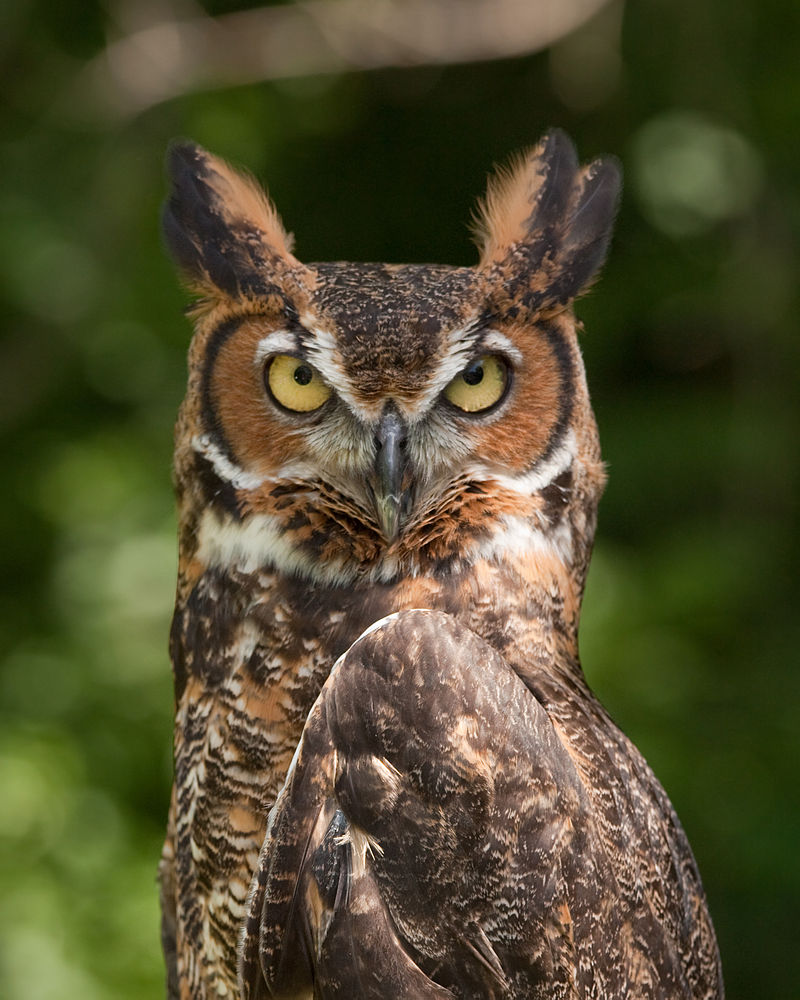
The Great Horned Owl is an impressive bird native to the Americas. It is well-known for its wide range and adaptability, as it can be found in many different habitats across the continent.
Its diet consists primarily of rabbits, hares, rats and mice; however, they are also known to consume skunks, geese and other birds too.
With their powerful talons capable of crushing prey with ease, these owls have earned themselves a fearsome reputation due to their incredible strength.
Their iconic horn-like tufts on either side of its head add another layer of intimidation which helps them stand out from other owls in the area.Scientific classification:
| Kingdom | Animalia |
| Phylum | Chordata |
| Class | Aves |
| Order | Strigiformes |
| Family | Strigidae |
| Genus | Bubo |
| Species | B. virginianus |
40. Eastern Meadowlark
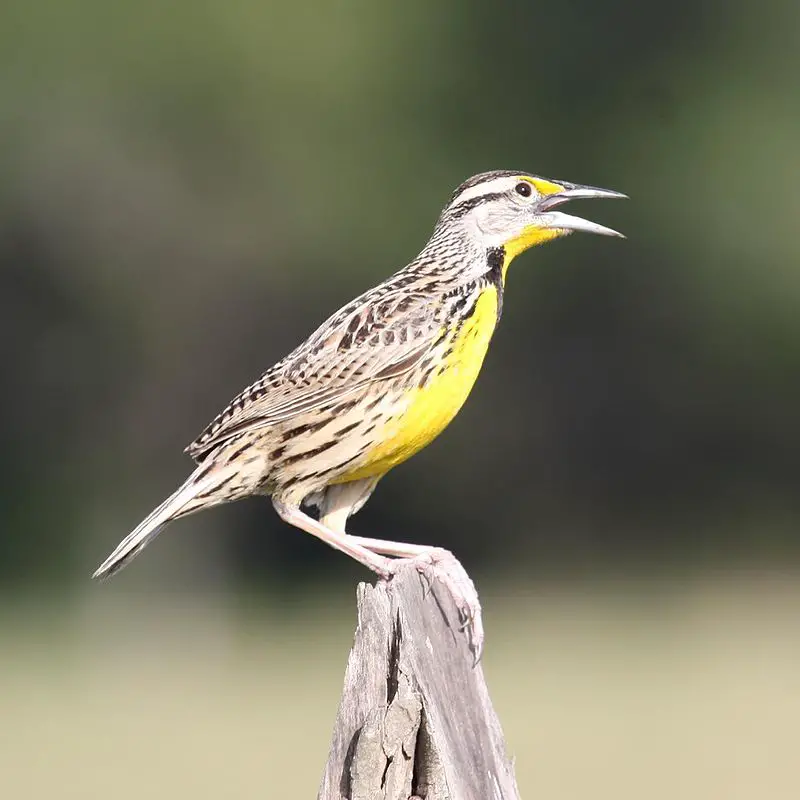
The Eastern meadowlark is a medium-sized blackbird, found from eastern North America to northern South America.
It used to be considered the same species as the Western meadowlark but has since been separated into its own distinct species.
The bird is mainly brown with yellow underparts and an orange patch on its throat; it also has white wing bars which can be seen in flight.
Its song consists of a series of musical whistles followed by gurgling notes at the end, earning them their nickname “rainmaker” birds because they are believed to bring rain if heard singing during dry weather.
These beautiful birds feed mostly on insects, seeds and other plant material while nesting amongst grasses or low shrubs near open fields where there’s plenty of food available for them.Scientific classification:
| Kingdom | Animalia |
| Phylum | Chordata |
| Class | Aves |
| Order | Passeriformes |
| Family | Icteridae |
| Genus | Sturnella |
| Species | S. magna |
41. Orchard Oriole
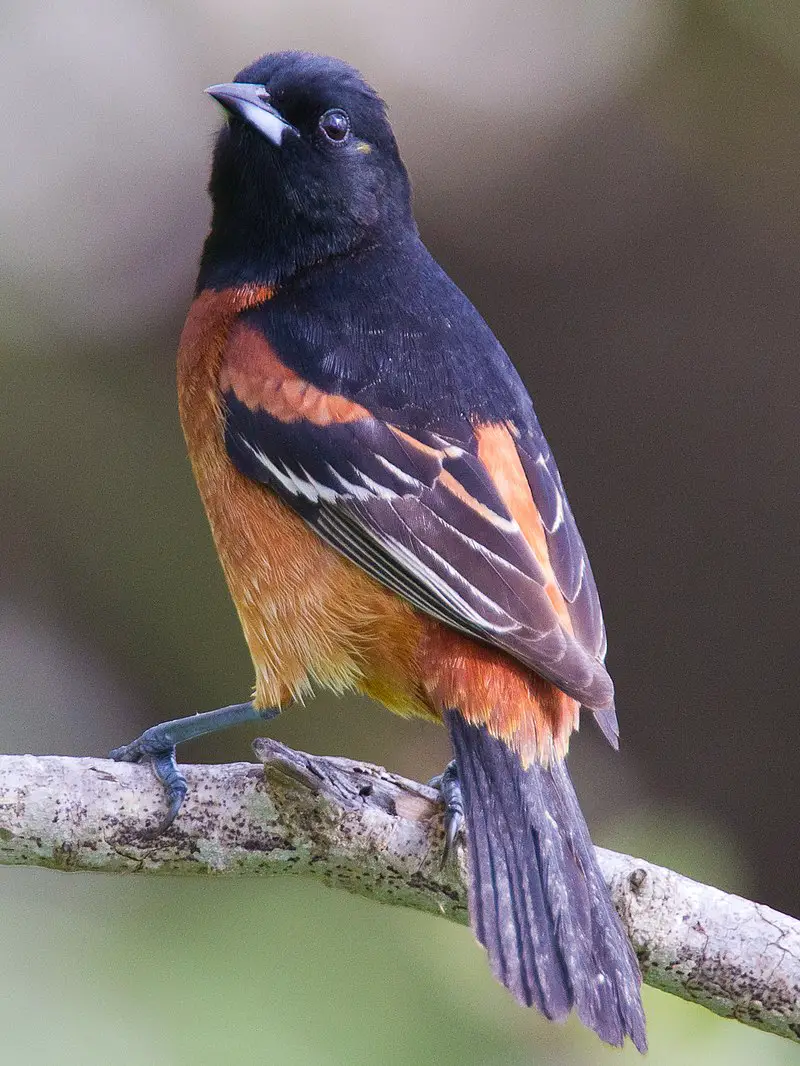
The Orchard Oriole is a small species of icterid bird, with the subspecies I. s. fuertesi sometimes considered its own separate species known as the Ochre or Fuertes’ Oriole.
The adult male of the nominate subspecies has chestnut upperparts and black wings and tail, while females are more yellowish-green in coloration on their back and wings.
Its bill is pointed, black in color with some blue-gray at the base of its lower mandible.
This beautiful bird can also be found across North America during migration season; they inhabit woodlands near streams or rivers to breed before migrating south for winter months.Scientific classification:
| Kingdom | Animalia |
| Phylum | Chordata |
| Class | Aves |
| Order | Passeriformes |
| Family | Icteridae |
| Genus | Icterus |
| Species | I. spurius |
42. Red-Breasted Nuthatch
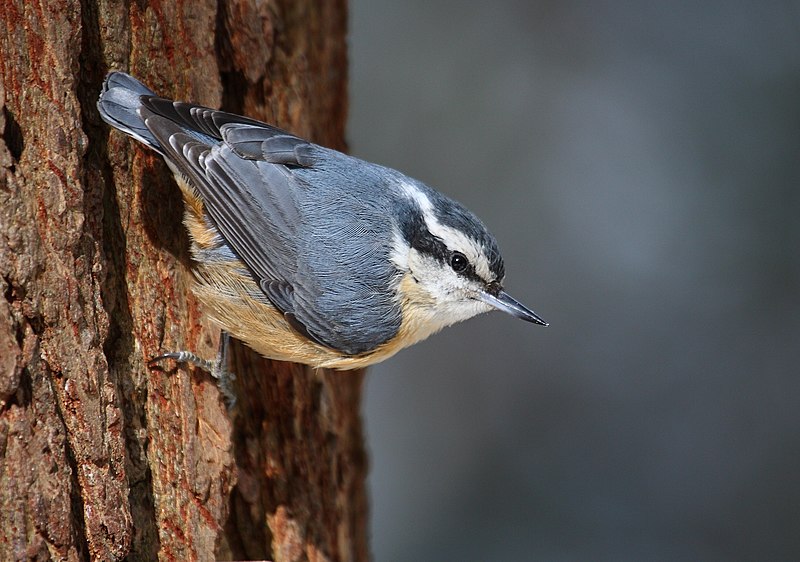
The Red-breasted Nuthatch is a beautiful and vocal songbird that can be found in coniferous forests across Canada, Alaska, the northeastern United States and western US.
This small bird has blue-grey upperparts with cinnamon underparts, a white throat and face with black eye stripe, straight grey bill and black crown.
Its call sounds like a tin trumpet; it’s high-pitched yet nasal.
During mating season they form monogamous pairs to build their nest near tree trunks or branches at low heights off the ground where they lay 2 – 8 eggs at once.
They are very active little birds who love clinging to trees while searching for insect larvae or seeds within the bark of trees which helps control pest populations.Scientific classification:
| Kingdom | Animalia |
| Phylum | Chordata |
| Class | Aves |
| Order | Passeriformes |
| Family | Sittidae |
| Genus | Sitta |
| Species | S. canadensis |
43. Chipping Sparrow
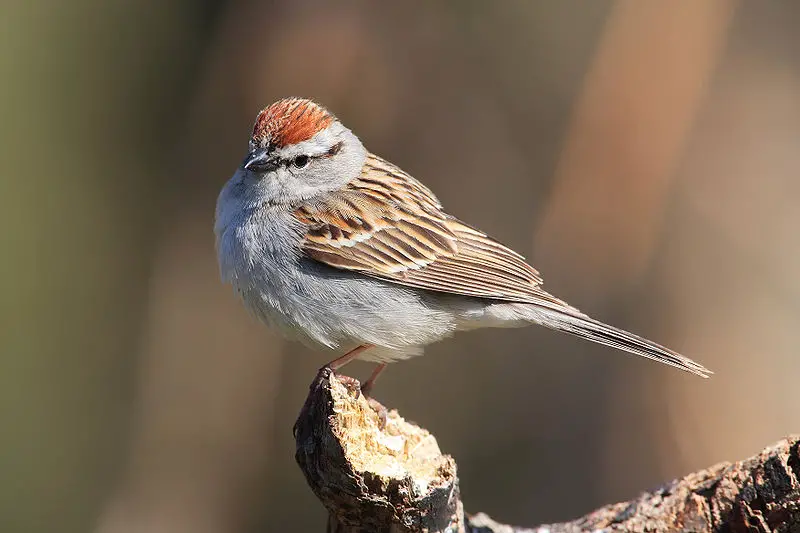
The Chipping Sparrow is a small passerine bird found across most of North America. It has two subspecies, the eastern and western chipping sparrows which migrate seasonally to overwinter in warmer climates.
The birds are grey above with white underparts, have a rufous cap with black stripes and large eyes surrounded by light brown feathers.
They feed mainly on seeds but can also be seen eating insects during breeding season when raising their young chicks.
These intrepid little birds live in open grasslands such as prairies or meadows where they build cup-shaped nests in trees or shrubs to raise their young family.
Their cheerful song often sounds like ‘chips’ hence its name; Chipping Sparrow.Scientific classification:
| Kingdom | Animalia |
| Phylum | Chordata |
| Class | Aves |
| Order | Passeriformes |
| Family | Passerellidae |
| Genus | Spizella |
| Species | S. passerina |
44. Brown-Headed Cowbird
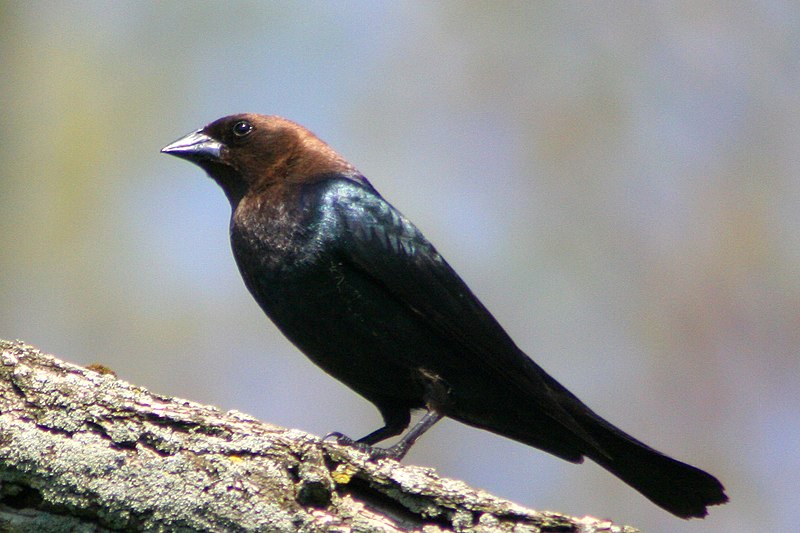
The Brown-headed Cowbird is a small, obligate brood parasitic icterid native to temperate and subtropical North America. It has a brown head with glossy black plumage on the body, wings and tail feathers.
During summer months it can be found in prairies, grasslands as well as open wooded areas but during winter they migrate southwards towards the United States of Mexico for warmer climate.
They are mainly insectivorous birds which feed on insects like caterpillars or beetles but also consume some grains too.
The female bird lays its eggs in nests of other species who then incubates them until hatching time thus leaving their own chicks uncared for by themselves.Scientific classification:
| Kingdom | Animalia |
| Phylum | Chordata |
| Class | Aves |
| Order | Passeriformes |
| Family | Icteridae |
| Genus | Molothrus |
| Species | M. ater |
45. Tundra Swan

The Tundra swan is a small species of swan found in the Holarctic region. It can be divided into two separate taxa, Bewick’s Swan and Whistling Swan.
The former inhabits the Palearctic area while the latter resides near North America.
These birds are typically white with black bills and eyes but their legs vary from yellow to greyish-black depending on which subspecies they belong to.
They feed mainly on aquatic plants such as algae, roots, tubers and various types of seeds.
During migration these birds fly together in large flocks that may contain hundreds or even thousands of individuals at one time.
This majestic bird is an important part of many wetland ecosystems around the world where it plays a vital role in controlling vegetation growth as well as dispersing nutrients across its habitat range.Scientific classification:
| Kingdom | Animalia |
| Phylum | Chordata |
| Class | Aves |
| Order | Anseriformes |
| Family | Anatidae |
| Genus | Cygnus |
| Species | C. columbianus |
46. Red-Tailed Hawk
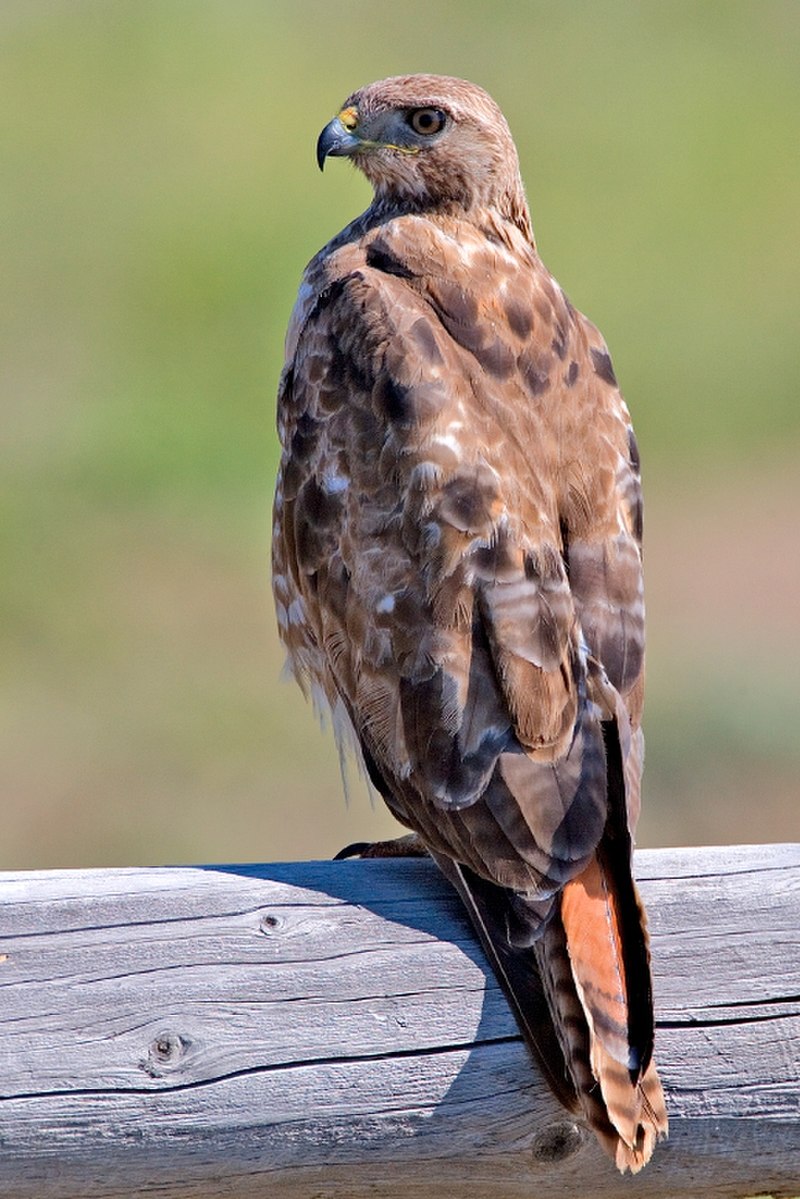
The Red-tailed Hawk is a majestic bird of prey with its distinctive red tail. It can be found throughout North America, from Alaska in the north to Panama and the West Indies in the south.
This species belongs to Buteo genus, which makes it one of most common raptors on earth.
These hawks mainly hunt small mammals such as rabbits or squirrels but also feed on reptiles and birds during migration season.
Unlike other predator birds, they prefer open areas for hunting like fields or grasslands rather than dense forests.
They build their nests high up on trees where they stay all year long unless disturbed by humans or animals nearby.
Their presence has become an iconic part of American culture due to their frequent sightings around homes and parks alike making them beloved creatures among people everywhere.Scientific classification:
| Kingdom | Animalia |
| Phylum | Chordata |
| Class | Aves |
| Order | Accipitriformes |
| Family | Accipitridae |
| Genus | Buteo |
| Species | B. jamaicensis |
47. Ruby-Crowned Kinglet
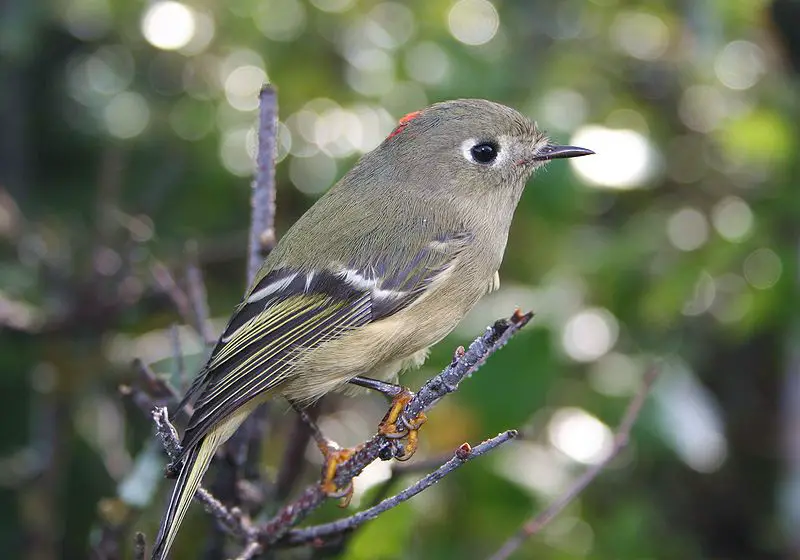
The Ruby-crowned Kinglet is a small passerine bird native to North America. It has olive green plumage, white wing bars and an eye-ring as well as a distinctive red crown patch on the males.
Juveniles look similar to adults with no distinguishing features other than size.
They are usually found in coniferous forests or woodlands where they spend much of their time searching for insects among foliage and branches while constantly flitting from place to place.
These birds have incredible energy levels that allow them to travel long distances during migration season without getting exhausted too quickly, making them one of nature’s most resilient species.Scientific classification:
| Kingdom | Animalia |
| Phylum | Chordata |
| Class | Aves |
| Order | Passeriformes |
| Family | Regulidae |
| Genus | Corthylio Cabanis, 1853 |
| Species | C. calendula |
48. Summer Tanager
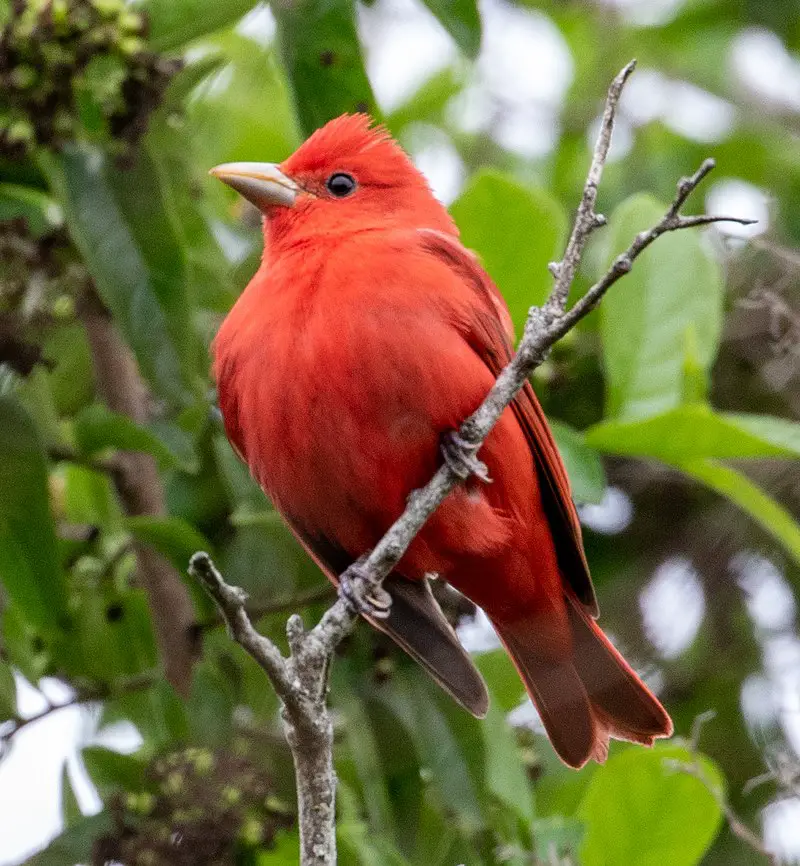
The Summer Tanager is a stunningly beautiful member of the cardinal family. Native to North and South America, this medium-sized songbird features striking red plumage on its back with yellow underparts.
It has a pointed black bill and long tail feathers that can be seen fluttering through the air when it flies.
The species’ vocalizations are quite similar to those of other members of its genus as well, which often include short whistles and chirps in addition to longer songs made up of various phrases or syllables.
With their vibrant colors and melodic voices, these birds make an eye-catching sight any time they appear.Scientific classification:
| Kingdom | Animalia |
| Phylum | Chordata |
| Class | Aves |
| Order | Passeriformes |
| Family | Cardinalidae |
| Genus | Piranga |
| Species | P. rubra |
49. Purple Martin
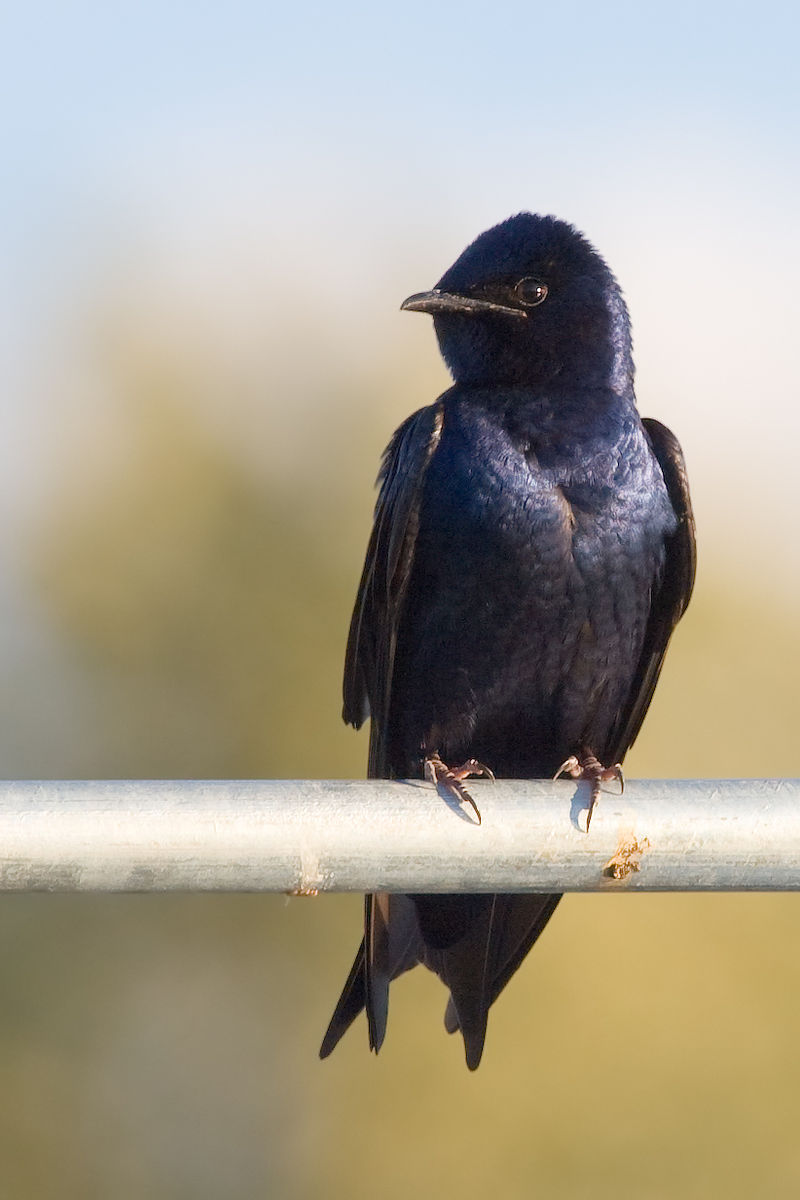
The Purple Martin is a beautiful passerine bird in the swallow family, and is the largest of its kind in North America.
It has dark blackish-blue feathers that have an iridescent sheen which can make them appear blue or deep purple depending on the light; they may even look green.
These birds are quite social creatures and often build communal roosts with multiple nests, having as many as hundreds of individuals living together at once.
They feed mainly on flying insects such as flies, moths, wasps and bees.
Their habitats include areas near bodies of water like lakes or rivers where there’s plenty for these birds to eat all year round.
The Purple Martin is truly an amazing species worth protecting.Scientific classification:
| Kingdom | Animalia |
| Phylum | Chordata |
| Class | Aves |
| Order | Passeriformes |
| Family | Hirundinidae |
| Genus | Progne |
| Species | P. subis |